King Mongkut’s University of Technology Thonburi (KMUTT) actively contributes to Sustainable Development Goal (SDG) 7, which aims to ensure access to affordable, reliable, sustainable, and modern energy for all. KMUTT’s involvement in this goal is primarily through its research and innovation in sustainable energy technologies.
The university’s research initiatives often focus on developing renewable energy sources, such as solar, wind, and bioenergy. These efforts are geared towards creating more efficient and cost-effective technologies that can be used not only in Thailand but also in other parts of the world, particularly in developing countries where access to energy is a major challenge.
KMUTT also integrates sustainable energy concepts into its curriculum, educating students about the importance of renewable energy and training the next generation of engineers and scientists in this field. This education is crucial for fostering a deeper understanding and commitment to sustainable energy solutions among future professionals.
Furthermore, KMUTT practices what it preaches by implementing sustainable energy solutions on its campus. This includes the use of solar panels and other energy-efficient technologies, serving as a model for sustainable energy practices and demonstrating the practical application of its research.
Through these research, educational, and practical initiatives, KMUTT plays a significant role in advancing SDG 7, contributing to the global effort to transition to more sustainable and environmentally friendly energy sources.
7.2 UNIVERSITY MEASURES TOWARDS AFFORDABLE AND CLEAN ENERGY
1. Related information on our university as a body having a policy in place for ensuring all renovations / new builds are following energy efficiency standards.
Energy and climate change at KMUTT is one of our focuses on the activities which comply to SDG 2030 Goal 7-Affordable and clean energy and Goal -Climate action. To ensure access to affordable, reliable, sustainable and modern energy, we provide and strictly follow the energy reduction policy, renewable energy usage policy and greenhouse gas emission reduction policy including the energy efficient appliances usage, the implementation of smart buildings /green buildings, total electricity use, energy conservation programs, climate change adaptation and mitigation programs. Moreover, we have our plan to facilitate access to clean energy research and technology, including renewable energy, energy efficiency and advanced and cleaner fossil-fuel technology, and promote investment in energy infrastructure and clean energy technology.

In response to conserve energy and climate change , KMUTT set up sustainable energy management within KMUTT to
follow the guidelines for energy conservation in designated building, promote the energy conservation and energy
substitution usage within university, KMUTT is committed to
1. Responsibility to climate change and energy sustainability and dedicated to confronting these responsible through
cooperate into all activities on campus.
2. Set up energy management systems including annual implementation plan, monitoring and evaluation system by
continuing to focus on the participation of all sectors of the KMUTT community.
3. Set up the energy conservation rules and procedures and implement to all sectors within KMUTT.
4. Promote and create awareness of energy conservation among staff and students with continual improvement for
sustainability.
5. KMUTT’s Carbon Neutrality 2040
6. 5% renewable energy usage within KMUTT by 2024.
7. 1% energy consumption reduction per capital per year.
Building and Ground Management Policy
A policy for the benefit of KMUTT’s Building and Ground
Physical Development Master Plan (41+C)
KMUTT sets up a Physical Development Master Plan with the goal of making KMUTT an open place, creating an atmosphere of learning and social participation, a green university, an educational garden, a common space for multi-purpose co-working, and a walking-focused design.
- There is a working committee (Area Master Plan Committee: AMPC) to consider the master plan, regulate construction plan, and ensure that the area is used in accordance with the plan.
Design of rooms divider, decorations, renovation or changes in the use of spaces in every building.
The results from the study on our building construction, renovation, and expansion at KMUTT can be implemented in accordance with the KMUTT’s space utilization criterion standards. There is a guideline for this practice, which is as follows:
- Maximize the benefit of space utilization
- Concern the appropriateness of health and safety
- Benefit of saving energy
- Consider the neatness and beauty of the workplace, as well as a delightful working environment
- Consider the flexibility to shift the process of use.
KMUTT Green & Sustainable Development Policy
Policy development for transforming the KMUTT into a green, sustainable university
Since 2003, KMUTT has committed to be an environmental leader in all activities, including practice, teaching, research and development, with the following commitments:
- To be a model of green university for energy, environmental, and safety management systems in collaboration with the community.
- To produce high-quality graduates who will serve as Thai social change agents for sustainable development.
- To be an excellent organization in accordance with the TQM concept in order to continuously develop and improve the energy, environmental and safety management system
A policy for green university
Revisions of the Green university policy in the framework of KMUTT Educational Reform include:
- Plant the vegetation on the balcony of the President’s Office Building and other buildings to increase the amount of green space, reduce heat entering the building, and reduce the campus heat island.
- Construct the Green Society building to improve collaborative learning and to establish a green social network.
- Provide a walking campus to reduce fuel consumption from cars and pollution in the university by limiting car access and providing a covered walkway, as well as a parking area for cars, motorcycles, and bicycles in adequate and appropriate locations. (Since 2021)
2. Related information on our university as a body having plans to upgrade existing buildings to higher energy efficiency.
Upgrading all existing building by replacing conventional appliances by energy efficient appliances
Goal: Actively contribute to energy reduction and implementation of energy efficient appliances and renewable energy usage.
Target: 100% energy–efficient appliances usage in KMUTT by 2025
Results: In 2024, 92.5% of appliances are energy–efficient appliances
Energy and Climate Change
To meet the energy and climate challenge by 2024 which are related to SDG 7, SDG 13, and SDG 15, we actively work on energy reduction, implementation of energy efficient appliances, renewable energy usage, and green area expansion
Energy and climate change at KMUTT focuses on the activities which comply to SDG 2030 Goal 7-Affordable and clean energy and Goal 13-Climate action to ensure access to affordable, reliable, sustainable, and modern energy. KMUTT concerns to the use of energy and climate change issues and provide the energy reduction policy, renewable energy usage policy and greenhouse gas emission reduction policy including the energy efficient appliances usage, the implementation of smart buildings/green buildings, total electricity use, energy conservation programs, climate change adaptation and mitigation programs. Moreover, we have our plan to facilitate access to clean energy research and technology, including renewable energy, energy efficiency and advanced and cleaner fossil-fuel technology, and promote investment in energy infrastructure and clean energy technology. Energy conservation program in KMUTT consists of two main parts: (1) Raising awareness and (2) Technical application. KMUTT has been concerned about raising awareness in energy usage reduction and making a sustainable energy community which focus on students, staffs and communities surround by activities to promote the campaign held by Green Heart through printed posters and other medias including roadshows. According to KMUTT’s Energy Efficiency development plan, the University sets a target to reduce 25% of energy usage by the year 2030, compared to 2018 basis. All traditional office equipment and appliances are aimed to be replaced with energy efficient appliances by 2030 as energy efficient appliances use less electricity to achieve the same level of performance to similar models with the same size or capacity. All departments in campus are responsible for energy conservation and to promote this concept. Energy Label No.5, High Energy Efficiency label and Energy star are three key energy labels to look for when buying new appliance. The results of energy efficiency appliances implementation will result in cumulative energy saving and cumulative CO2 emission reduction from KMUTT campuses.

The following table shows the total number and percentage of replacement for energy efficient appliances
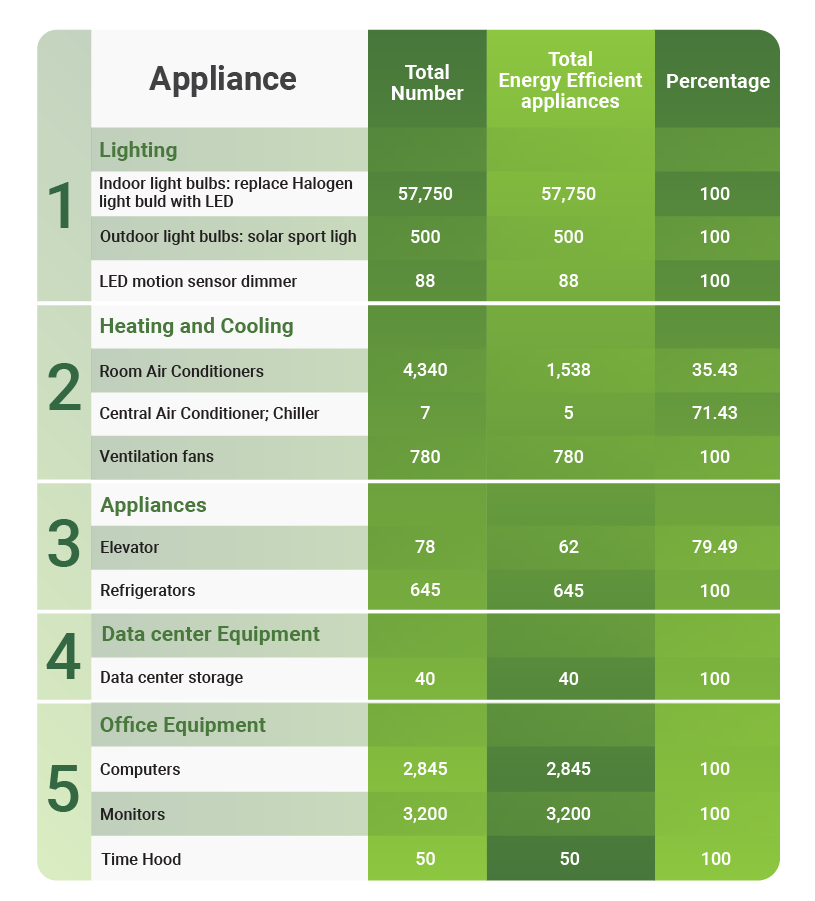
During 2018 – 2019, KMUTT has been granted 70 million-baht (2 million dollar) funding from the Department of Alternative Energy Development and Efficiency, Ministry of Energy, Thailand, to install new energy efficient appliances (i.e. lighting system, air conditioning system) for all areas in KMUTT with 6.67 years payback period.
In 2021, energy usage reduction in KMUTT from this project is 3,522,999.20 kWh which saved 14,373,836.73 Baht. Furthermore, the results from this project would reduce 1,761.14 metric tons carbon emission within the university. Technical application for energy efficiency in KMUTT has been continuously implemented to meet energy usage reduction goal and sustainable energy inside the campus.
1. Indoor Lighting system

53,750 T5 fluorescent lamps were replaced with Light-emitting diode (LED) and compact fluorescent lights in 24 buildings at KMUTT Bangmod campus. T8 lamp is a LED lamp with the compatible T8 lamps to reduce the need of all replacement, the potential contamination from toxic substances, and packaging materials needed for shipment and sale. Therefore, T8 lamps create less impact on the global environment than conventional T5 lamps. T8 lamps can reduce energy consumption up to 40% compared to T5 lamps. As result, KMUTT could save energy consumption more than 1.27 MWh/year, reducing electricity cost about 5.34 M THB/Year and reducing carbon emission at 717 metric tons.
2. Outdoor Lighting pathway
500 LED spotlights are installed to provide optimum visibility in pathways around the campus. By replacing the conventional lamps, up to 378,500 kWh/Year of energy consumption can be saved, reducing electricity cost around 1,672,970 THB/Year and reducing carbon emission at 215 metric tons.
3. Air Condition System

The air conditioners, generally, have lifespans about 15 to 20 years. If our air conditioners are old and not economically worth to repair and maintain, we always buy a new air conditioner, with high efficiency by considerting at its seasonal energy efficiency ratio (SEER). SEER indicates the relative amount of energy needed to provide a specific cooling output.
4. Install solar power on the roof of 40 kWp.
In 2020, solar cells were installed on the roof of the building with a size of 40 kWp, resulting in energy savings of 73,000 kWh per year.

5. KMUTT has prepared an energy management report.
In each year, KMUTT has to submit energy management report to Department of Alternative Energy Development and Efficiency, Ministry of Energy, Thailand. The contents from report include Energy Management team, energy management assessment, energy conservation policy, potential assessment of energy conservation, target and implementation plan, and monitoring and evaluation of energy usage.
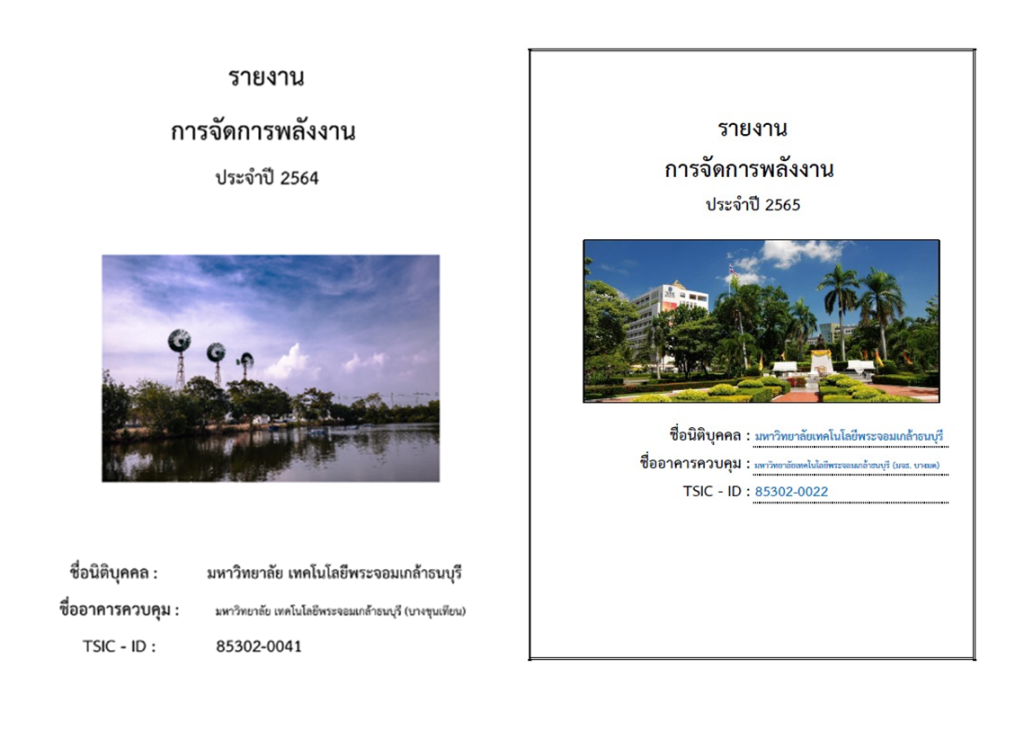



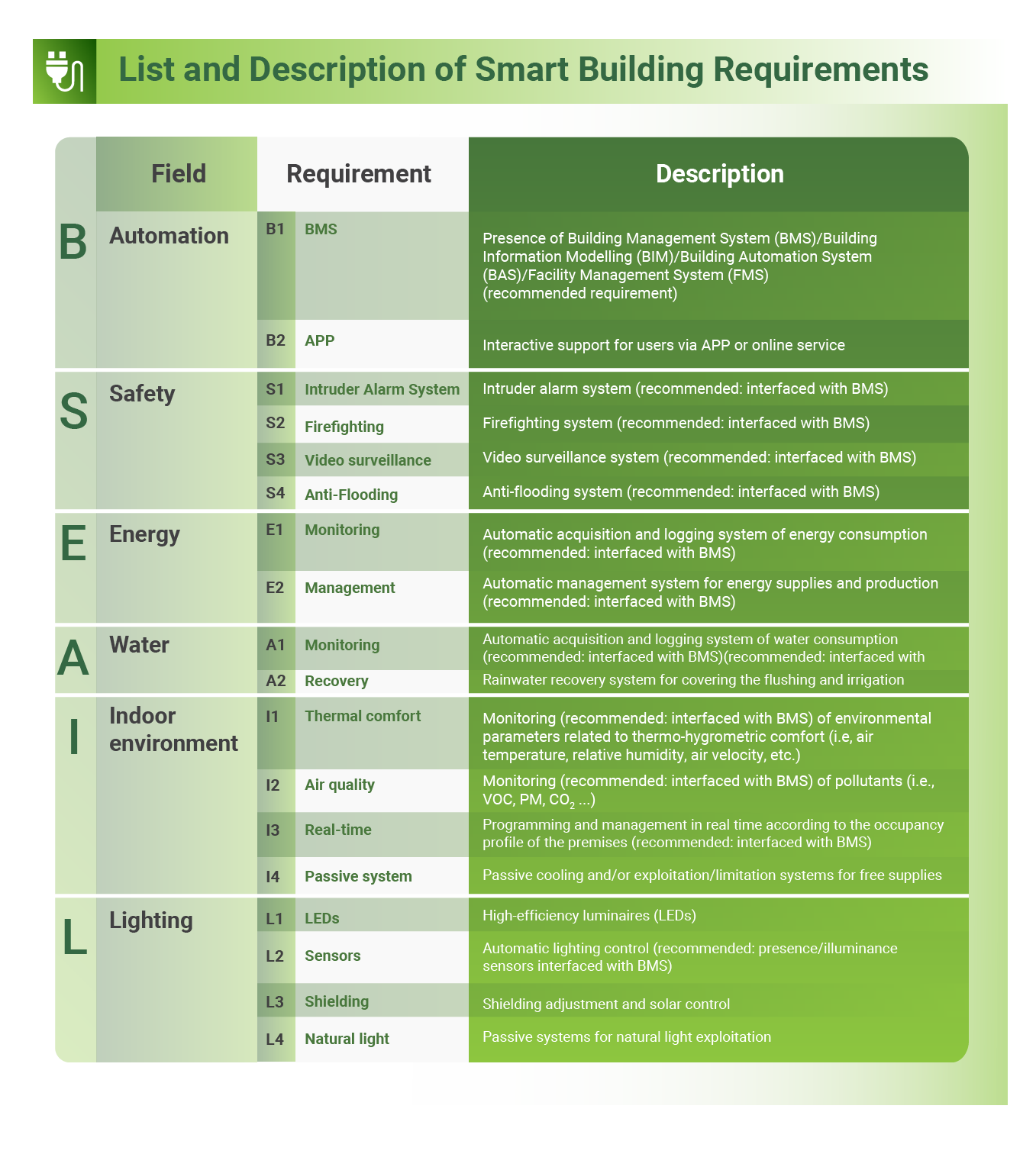







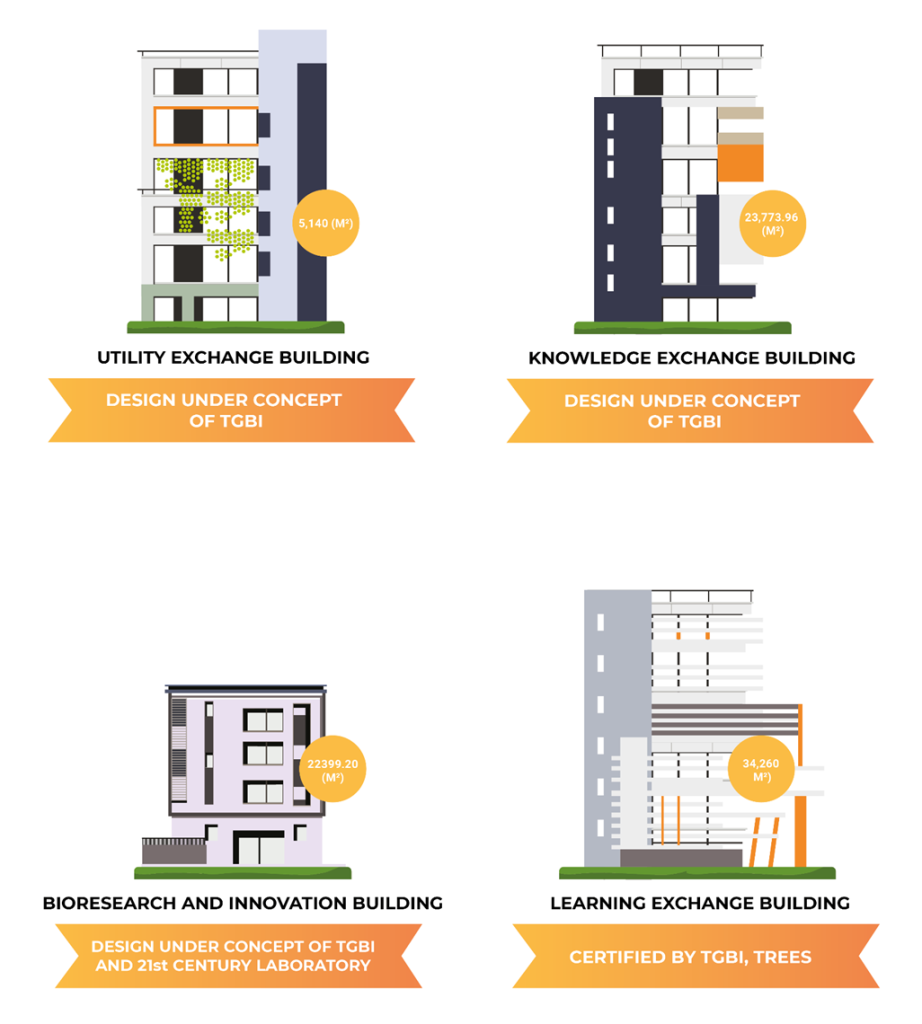
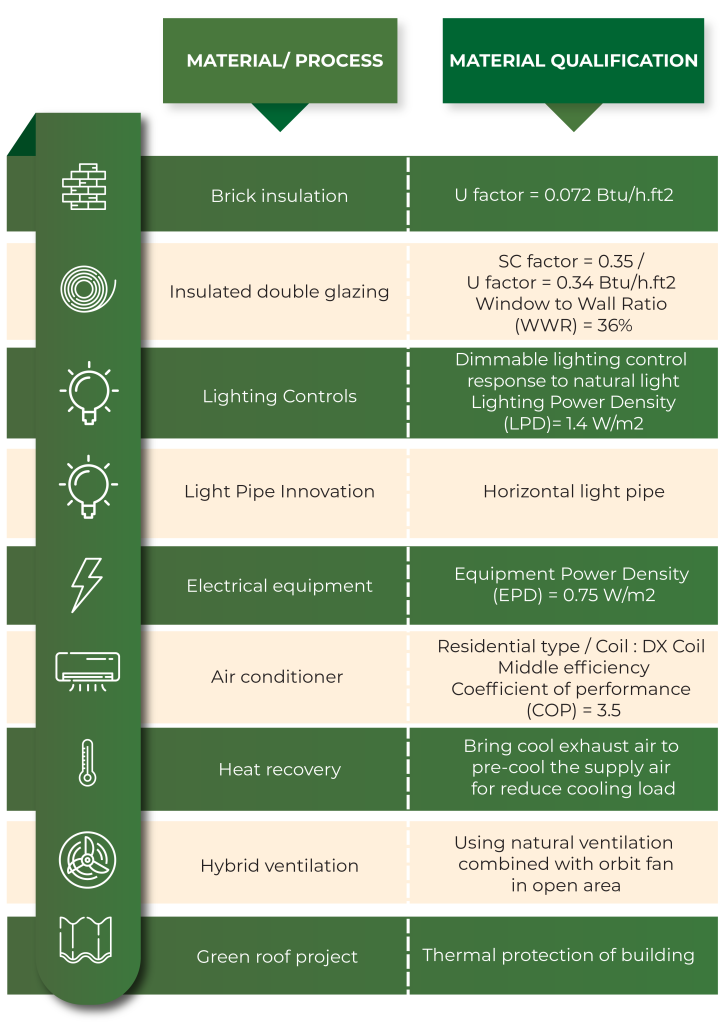
There are 6 projects to maximize energy efficient air conditioner between 2019 – 2022 as follows:
- Schedule a routine for maintenance visit at 3 times per year (Change or clean air filters)
- Replace existing central air conditioning system – air: cooled chiller plant at Library, President office and Gym with Screw Inverter Compressor, TRANE model: CRTAG 100, 150-300 Tons
- Replace traditional AC compressors with smart inverter air conditioners, allowing greater energy efficiency.
- Install solar power on the roof of 40 kWp
- Replaced high-performance elevators
- Fluorescent lamps are replaced with Light-emitting diode (LED)
- Planning install solar power on the roof of 2.9 MW
3. Related information on our university as a body having a process for carbon management and reducing carbon dioxide emissions.
Process for carbon management and reducing carbon dioxide emissions

Energy and Climate Change
To meet the energy and climate challenge by 2024 which are related to SDG 7, SDG 13, and SDG 15, we actively work on energy reduction, implementation of energy efficient appliances, renewable energy usage, climate change and green area expansion.
Energy and climate change at KMUTT focus on the activities which comply to SDG 2030 Goal 7-Affordable and clean energy and Goal 13-Climate action to ensure access to affordable, reliable, sustainable, and modern energy. KMUTT concerns to the use of energy and climate change issues and provide the energy reduction policy, renewable energy usage policy and greenhouse gas emission reduction policy including the energy efficient appliances usage, the implementation of smart buildings/green buildings, total electricity use, energy conservation programs, climate change adaptation and mitigation programs. Moreover, KMUTT has our plan to facilitate access to clean energy research and technology, including renewable energy, energy efficiency and advanced and cleaner fossil-fuel technology, and promote investment in energy infrastructure and clean energy technology.
At KMUTT, our researchers have access to a wide range of resources, which allow them to achieve their research ambitions on carbon footprint, and greenhouse gasesemission topics. School of Energy, Environment and Materials and The Joint Graduate School of Energy and Environment are the main school of university where study on climate change and environmental sustainability. Greenhouse Gas Emissions from Low Income House Construction in Thailandis one example of greenhouse gasesresearch study by applying Life Cycle Assessment theory to calculate carbon emission during construction process.
The Scope 3 emissions have been calculated as follows
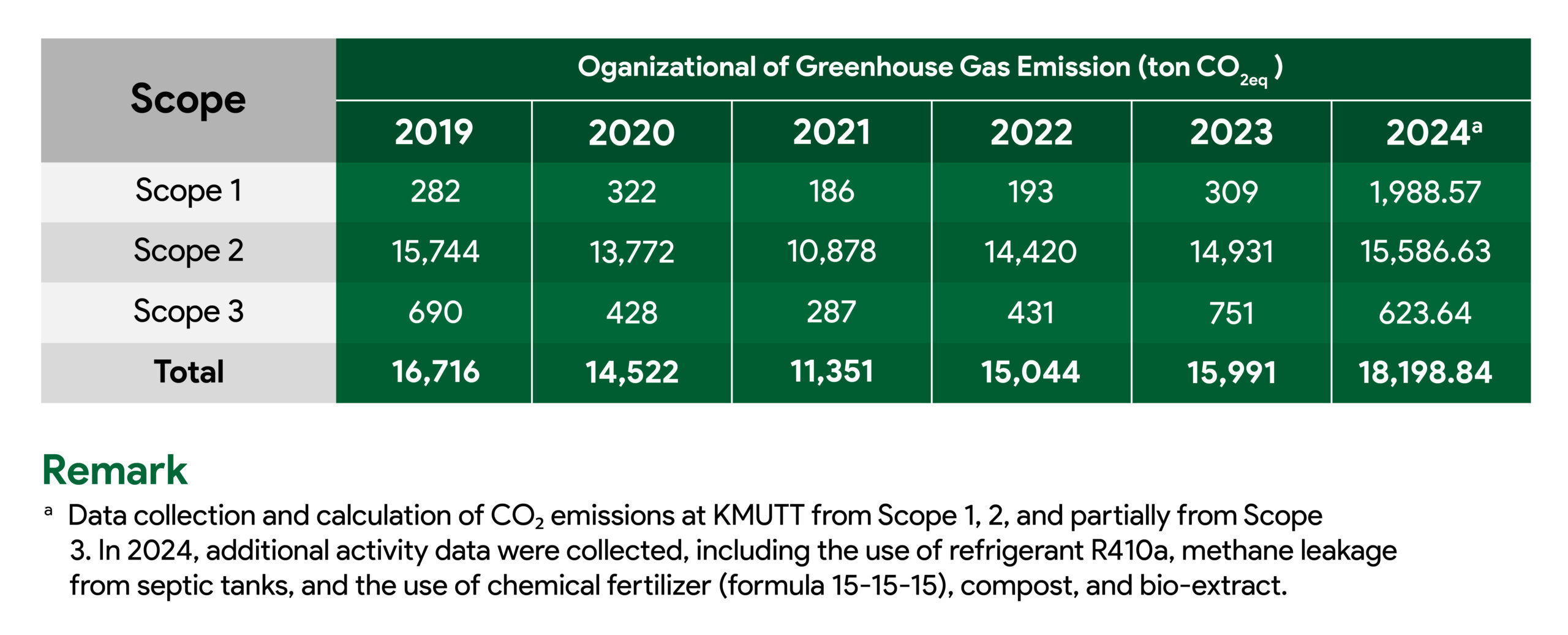
Carbon Footprint Per YearCurrent Status: in 2024 KMUTT Footprint Per Year is 16,376.6 Metric Ton
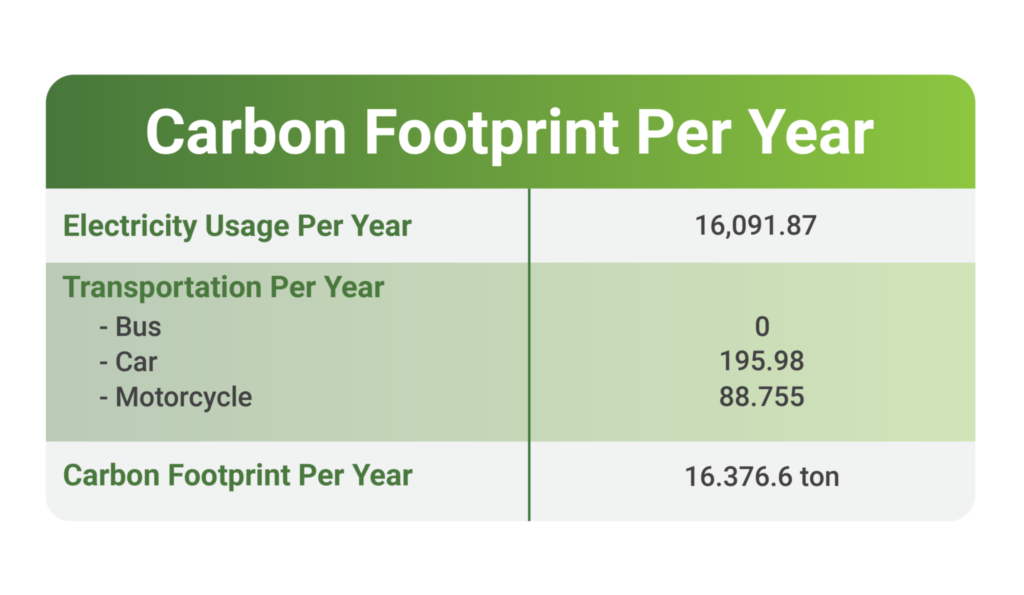
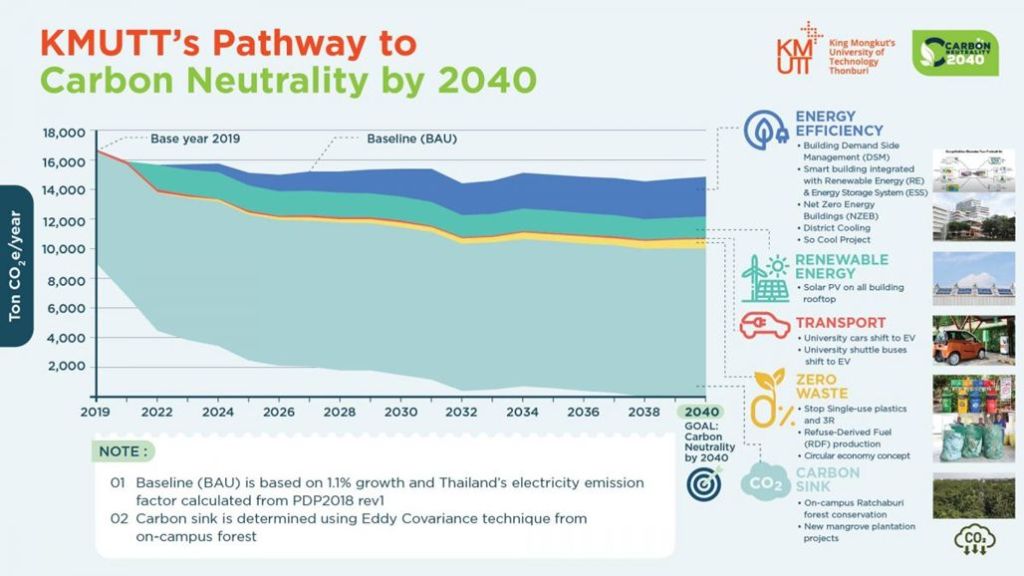
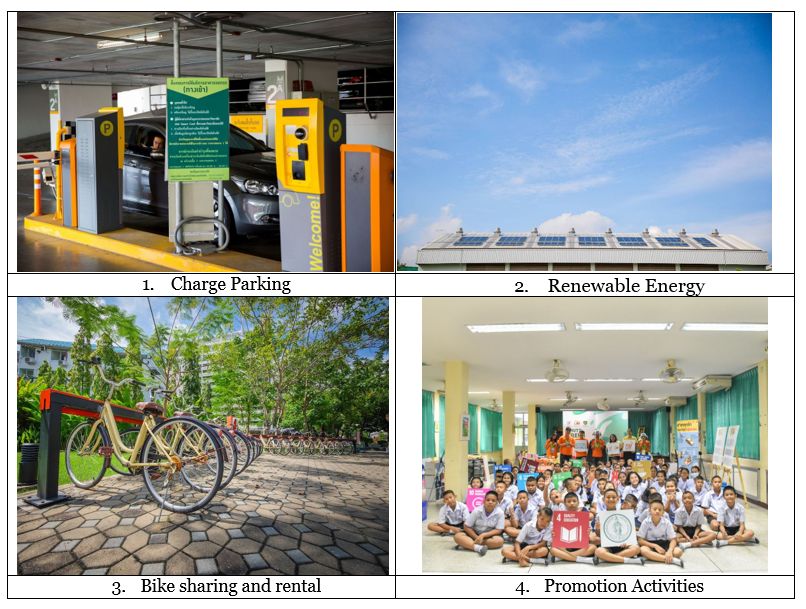
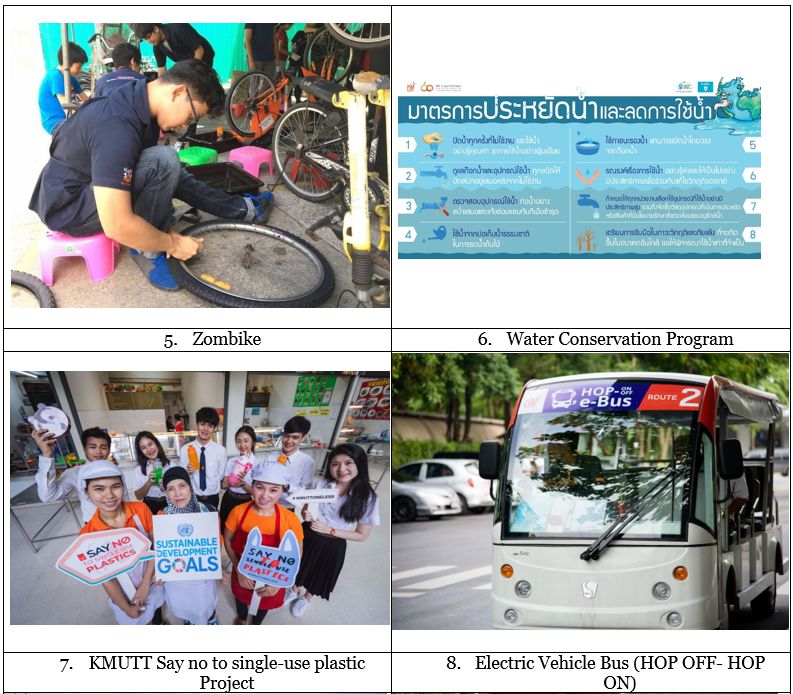
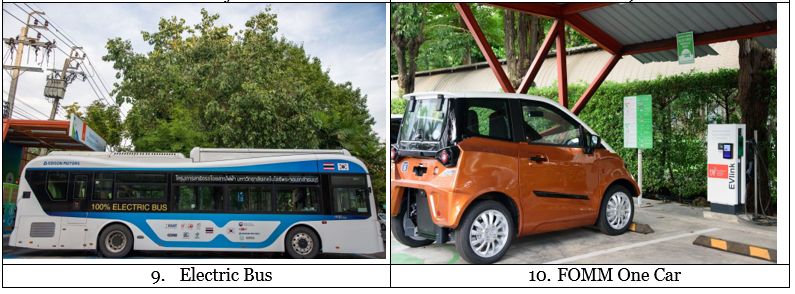
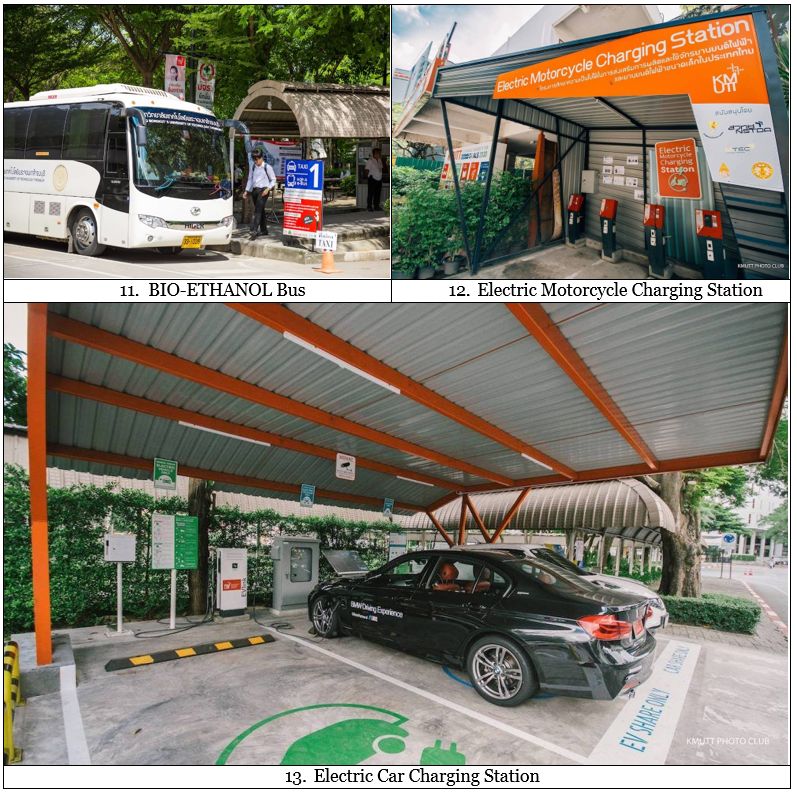
Description:
- Charge parking – According to KMUTT transportation policy, the limit on numbers of both private vehicles entering the campus and parking areas have been implemented since 2015. Even though, our campus either offering additional bicycle services (parking, repair shop and facilities) or providing public transport (EV shuttle bus), but some group of people still need using private car for travel. For this reason, more than 15 conventional car parking area around campus are cancel and replace with vertical car parking facility where provide more parking in less space (400 cars). These have been done to ensure a modal shift from private car to sustainable transportations (bus, van, bike, walk) which can improve quality of life and health. KMUTT aims to reduce the environmental impacts, initiates a sustainable traffic policy, and master plan improvement in order to limit the use of private car. For carpooling benefits, it reduces fuel costs with more environmentally friendly and sustainable transportation, reduces GHGs emissions, traffic congestion, and parking spaces reduction.
- Renewable Energy – KMUTT promotes to reduces the amount of fossil fuels used by integrating renewable energy with Metropolitan Electricity Authority for electricity consumption within campus. Using renewable energy not only serve the clean energy usage but also serve as Renewable Energy Learning Center for student, researcher and staff.
- Bike sharing and rental – KMUTT Green society is a place for anyone who love and interest on cycling. We are hoping this will encourage many more of student and staff to join both activities and club as cycling at the University will be much more accessible and affordable!
- Promotion Activities – KMUTT provides promotion activities by using Poster, Energy saving tips Pocket Guide, Leaflet, and Medias to promote within campus with monthly promotion activities plan.
- Zombike – KMUTT Green Bike Club creates the Zombike project in order to repair abandoned bicycles on campus. The zombike process consists of 10 steps that are: 1. Request for bicycle donation 2. Inspect bicycle 3. Decoration design 4. Prepare bicycle parts 5. Train the bicycle repair 6. Repair bicycle 7. Paint bicycle 8. Compose bicycle 9. Clean and decorate a bicycle 10. Promote Bike Share for Free
- Water Conservation Program – KMUTT’s water conservation measures are the first-line option for the control and management of water consumption within the campus. According to the Meteorological Department (MD), Thailand is going to experience the worst drought in a decade, as average precipitation across large swaths of the country has fallen far short of the monthly average. Therefore, KMUTT set the water conservation measures for applying to all campus for sustainable water management. KMUTT’s water conservation measures are including with:
- KMUTT Say no to single-use plastic Project – KMUTT set up Plastic Reduction program since 2015 and make our goal to “No BIG 4” single use plastics usage (Plastic Bags / Plastic bottles / Plastic Straws / Plastic spoon and fork) within KMUTT by 2020.
- Electric Vehicle Bus (HOP OFF- HOP ON) – We aim to replace motorbike using around our campus with electric mini bus
- Electric Bus – 100% Electric bus
- FOMM One Car – Electric car is supported by FOMM (ASIA) CO., LTD. for research on the innovation of small-scale electric vehicle technology in Thailand)
- BIO-ETHANOL Bus – As one of the nine National Research Universities in Thailand, KMUTT has been developed clean energy processing technology in pilot scale with Bioethanol Pilot plant from agricultural waste. This technology is now transfer to produce in commercial scale and make Thailand is one of a potential source of clean energy producer with 12% lower global warming emissions than diesel buses, travel between Bangmod and Bangkhuntien campus
- Electric Motorcycle Charging Station
- Electric Car Charging Station
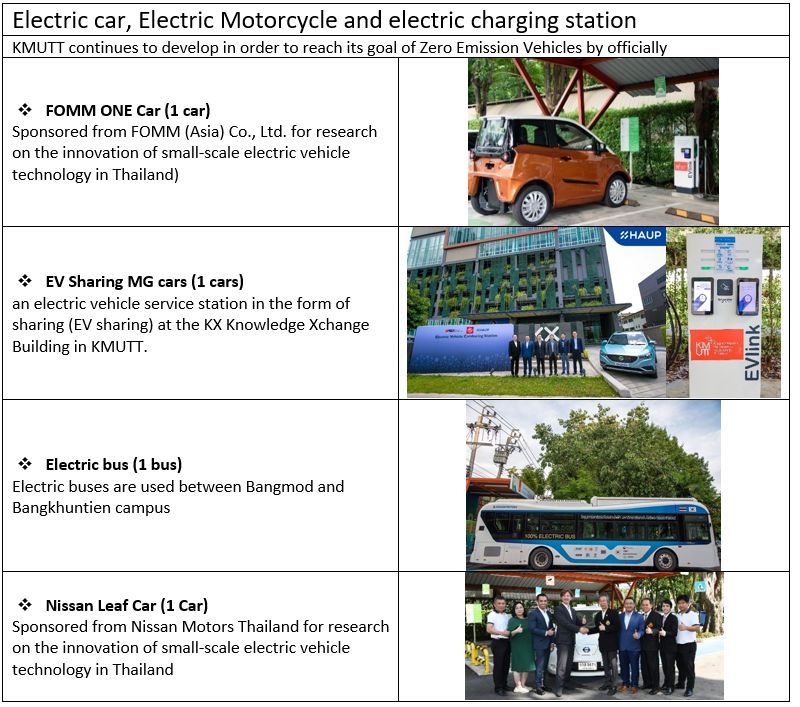
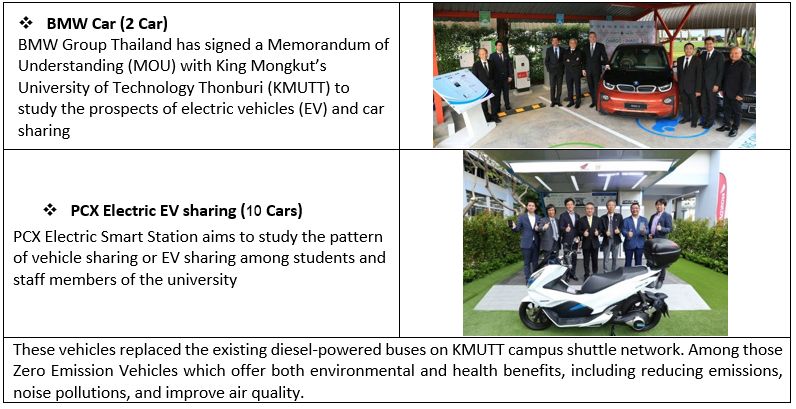
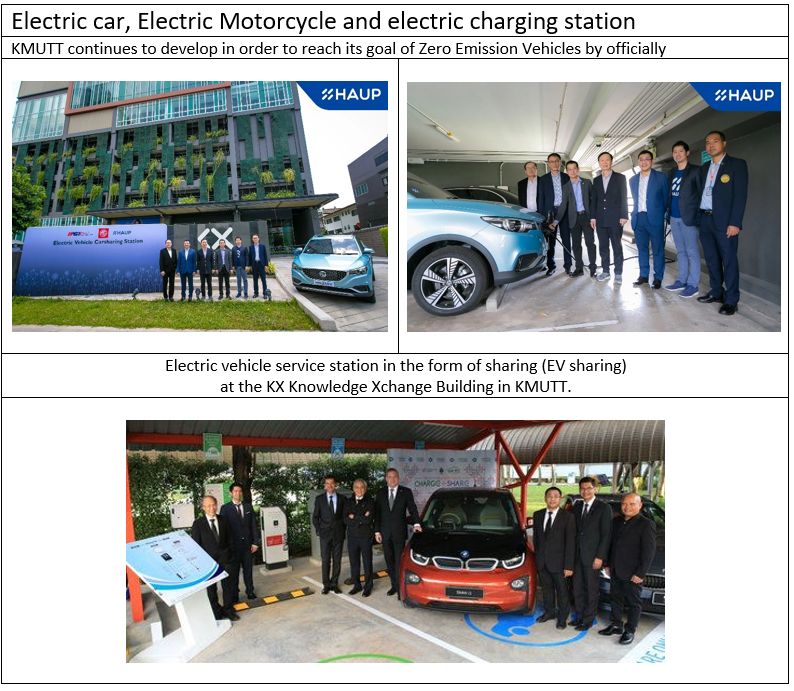
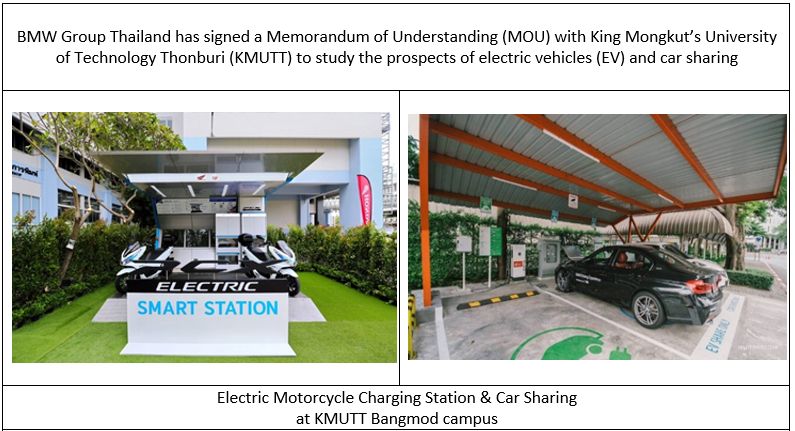
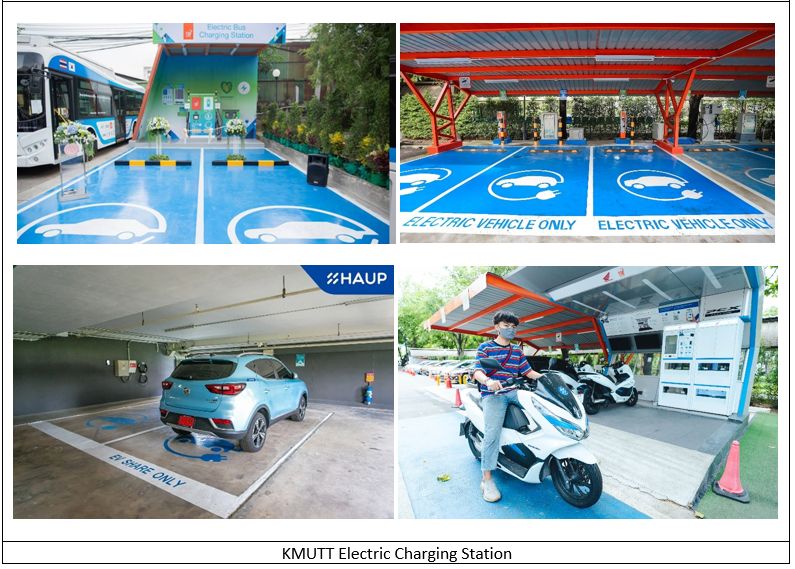
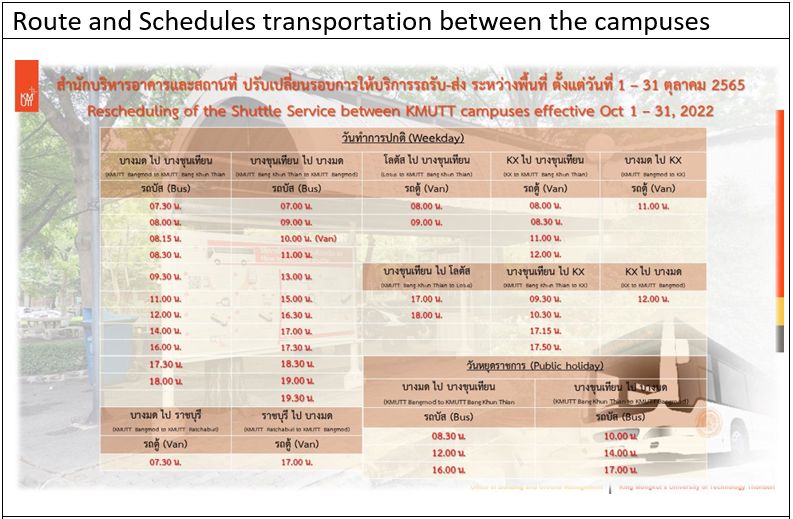
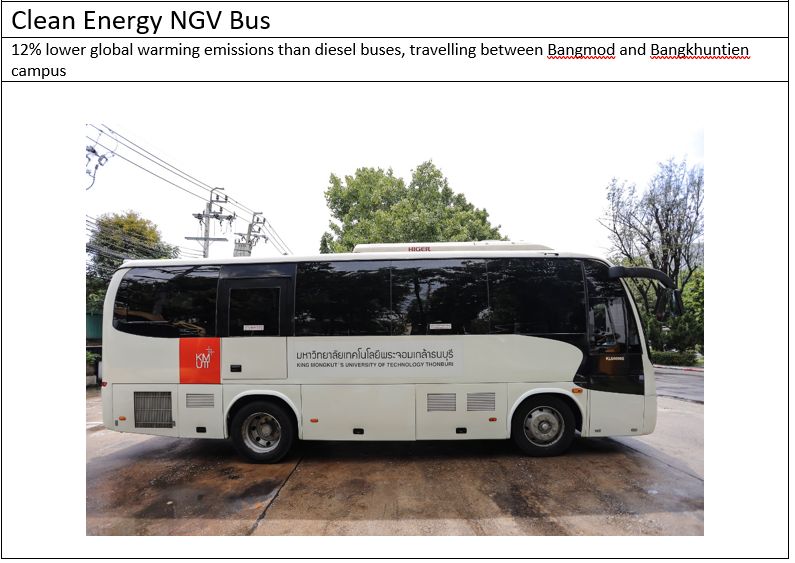
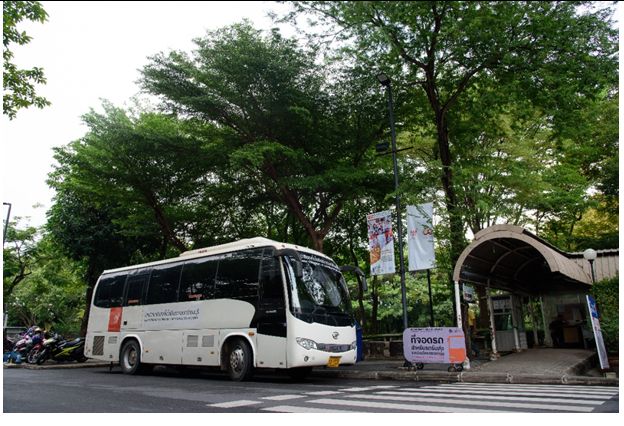


4. Related information on our university as a body having an energy efficiency plan in place to reduce overall energy consumption.
In each year, university gathering electricity usage data to analyze saving factor and create energy reduction plan. In 2021, 39.91% reduction on energy usage (capita/year) compared to 2003 baseline. Furthermore, KMUTT set target 40% reduction on energy usage (capita/year) by 2024 compared to 2003 baseline.
To reduce overall energy consumption, KMUTT’s energy efficiency plan is including with
1.Applying People ware, hardware and software concept
https://sustainable.kmutt.ac.th/energy-and-climate-change/electricity-uasge-per-year/
2.Replace appliances with energy efficient appliances
https://sustainable.kmutt.ac.th/energy-and-climate-change/energy-efficient-appliances-usage/
3.Install renewable energy
https://sustainable.kmutt.ac.th/energy-and-climate-change/renewable-energy-usage/
4.Construct green and smart building
https://sustainable.kmutt.ac.th/energy-and-climate-change/smart-building/
5.Organize energy training and workshop for students and staff
https://sustainable.kmutt.ac.th/energy-and-climate-change/involvement-and-activities/
6.Organize Energy and environmental conservation camp for students
https://sustainable.kmutt.ac.th/energy-and-climate-change/involvement-and-activities/
7.Promotion activities
https://sustainable.kmutt.ac.th/energy-and-climate-change/involvement-and-activities/
ELECTRICAL USAGE REDUCTION
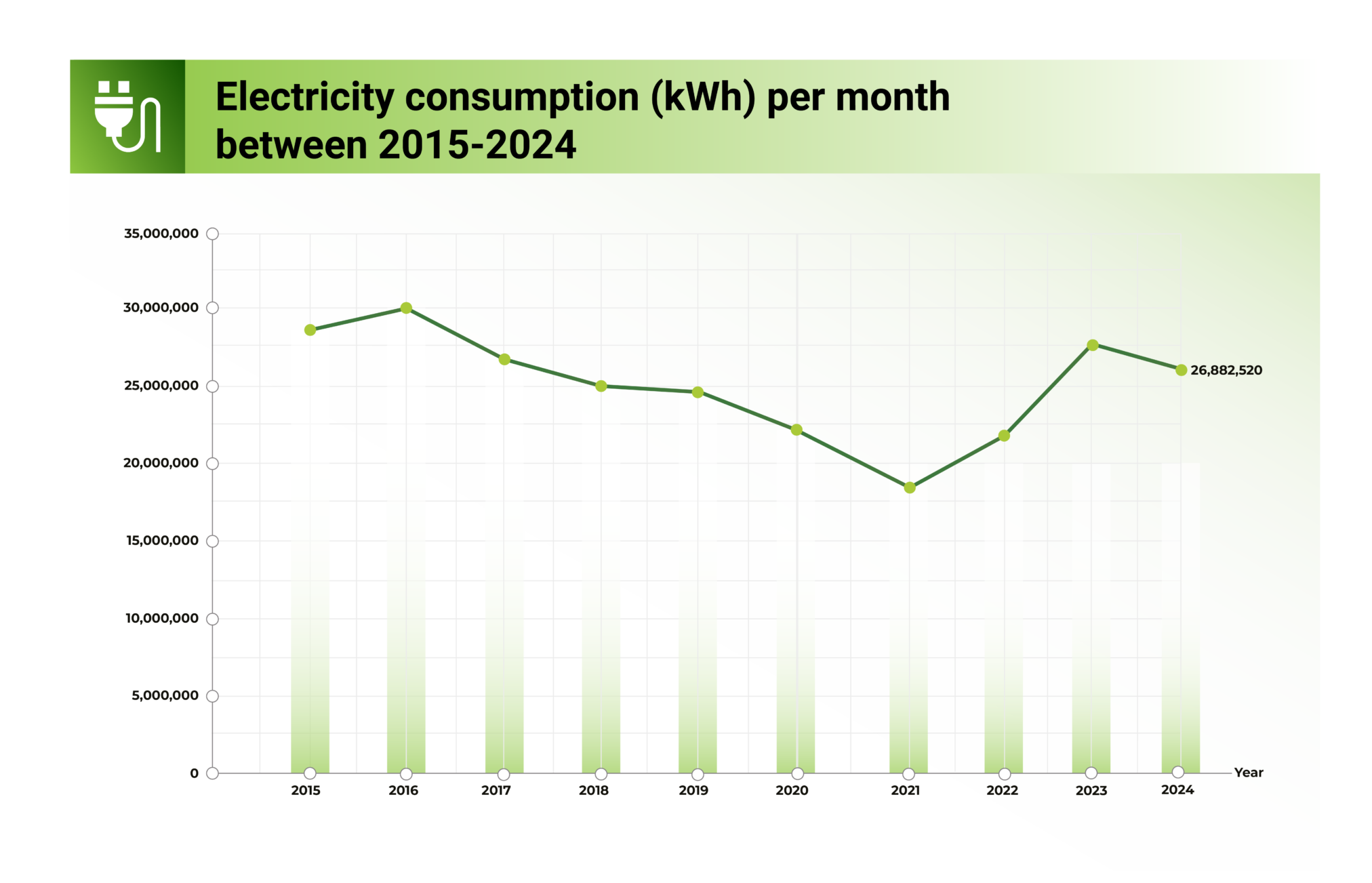
Targets: 40% reduction on energy usage (capita/year) by 2024 compared to 2003 baseline.
Current Status: In 2024, 40.5% reduction on energy usage (capita/year) compared to 2003 baseline.
The line graph represents electricity consumption at KMUTT between 2015 and 2024. The general view shows that electricity consumption has continued to decrease rapidly from 26,882,520 kWh (96,777.07GJ.) in 2015 to 17,694,516 (63,700.26 GJ.) kWh in 2021. This dramatic decrease represents the university’s high concern for saving electricity and energy conservation under the concepts of PEOPLEWARE, HARDWARE and SOFTWARE.
Peopleware refers to the human role in electricity conservation. Since KMUTT announced its Energy policy in 2018 in accordance to THAILAND’S ENERGY 4.0 policy to all students and staffs, with the aim to persuade people at campus for a better electricity consumption behavior, the university have been able to create various successful events defined by the number of attendees such as the 60+ Earth hour event , Energy Day at KMUTT and World Environment Day.
Hardware is the implementation of replacing inefficient equipment with energy efficient devices such as smart light and water sensors, LED lighting and inverter chiller as well as continuous work to promote energy efficient within campus. Furthermore, KMUTT has set the target to increase alternative energy like Solar energy (rooftop and floating panels) instead the usage of fossil fuels during peak load demand.
Finally, Software is a set of instructions, data or programs used to operate Building Automation System to study trends of energy consumption and power demand profile.
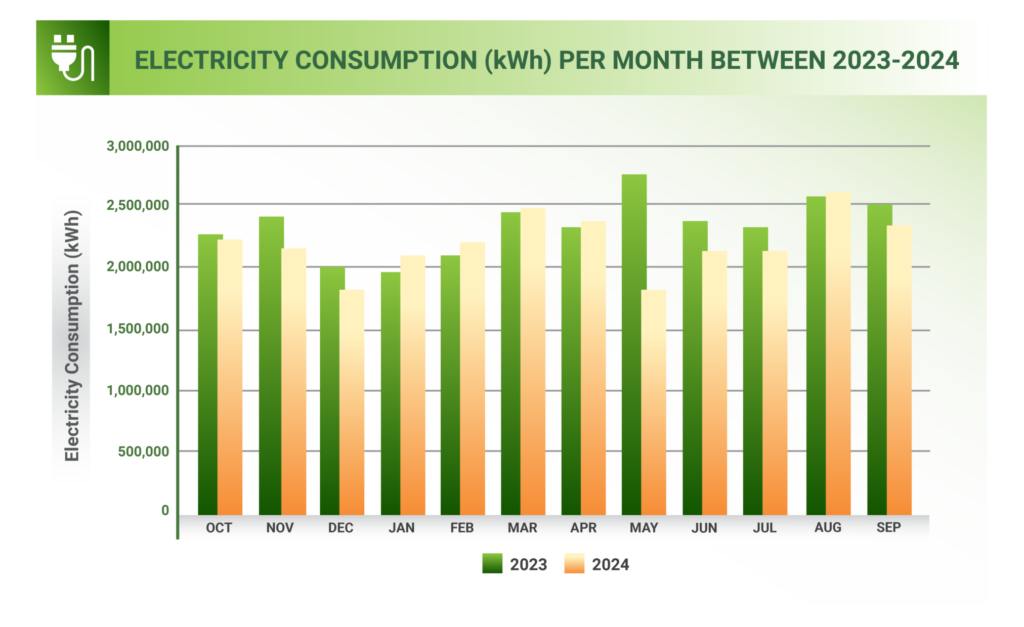
Electricity use at KMUTT from 2015 to 2024 is seen in this line graph. According to the widespread consensus, electricity usage has been steadily declining. This sharp decline shows how concerned the institution is about energy and electricity conservation using the PEOPLEWARE, HARDWARE, and SOFTWARE principles.
For Peopleware, it alludes to the part that humans play in conserving and preserving electricity. KMUTT informs all students and employees of its 2018 energy policy, which is based on Thailand’s Energy 4.0. The goal of this policy is to influence campus residents to use power more wisely. Additionally, we organize a variety of successful events that are measured by the number of attendees, such as World Environment Day, Energy Day at KMUTT, and the 60+ Earth Hour event. Moving on to hardware, efforts are being made to encourage energy efficiency on campus by replacing inefficient equipment with energy-efficient gadgets like smart lights, water sensors, LED lighting, and inverter chillers. Additionally, KMUTT has established a goal to increase the usage of alternative energy sources, such as solar energy (rooftop and floating), in place of fossil fuels during periods of peak demand. The last category is software, which is a collection of guidelines, information, or applications used to run a building automation system and analyze power demand profiles and energy consumption patterns.
The monthly electricity consumption for 2023-2024 is shown in this bar chart. The average monthly electricity use for KMUTT was 2,181,872 kilowatt-hours, according to the general perspective. December consumed the least amount of electricity (1,851,411 kWh), while March consumed the most (2,469,227 kWh). Due to the March Final Exam, the majority of students must study on campus, which is the primary reason for the rise in electricity consumption.

The continuously decreasing of electricity usage within campus is guaranteed by Thailand Energy Awards as following:
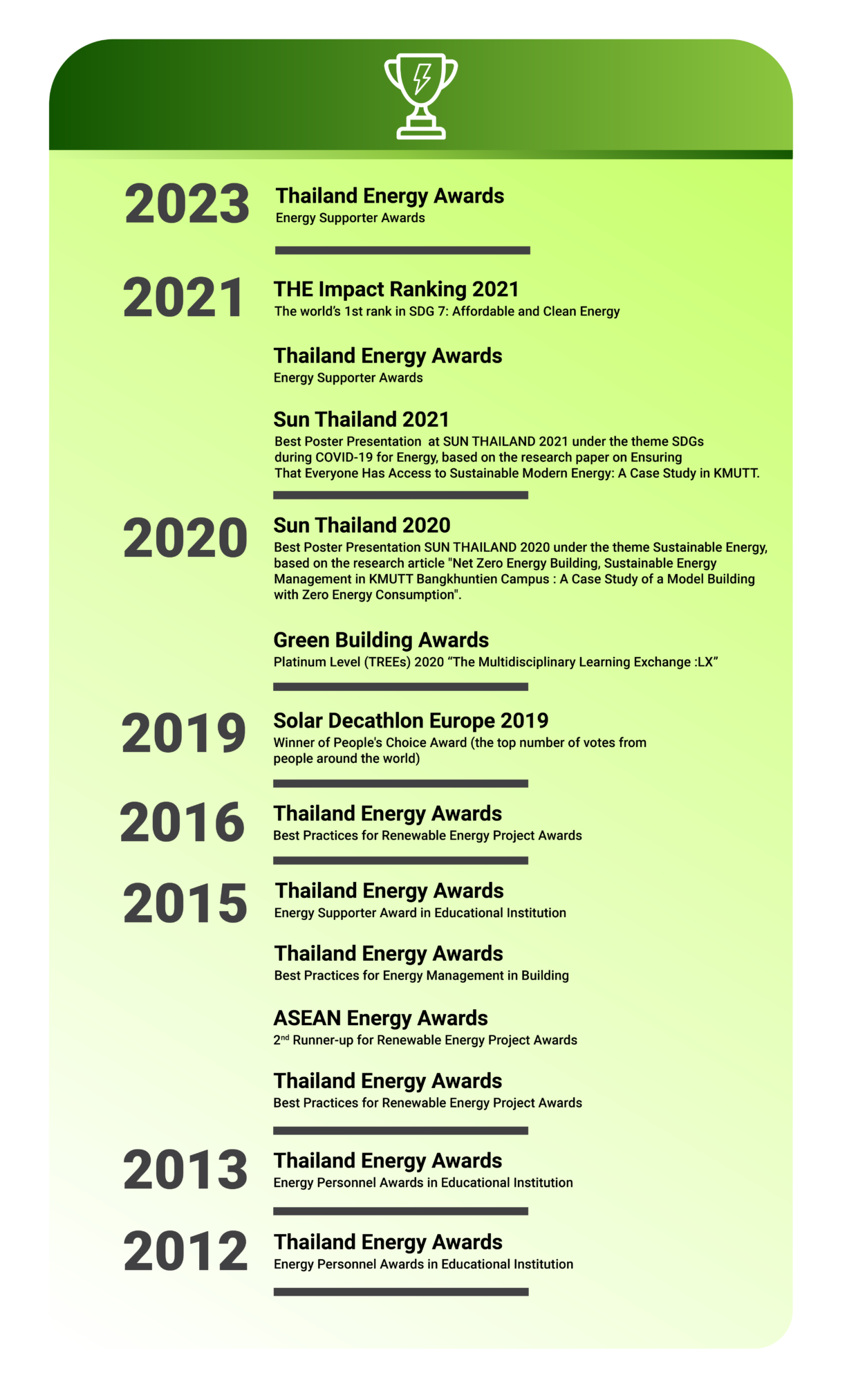
5. Related information on our university as a body undergoing energy reviews to identify areas where energy wastage is highest.
In each year, KMUTT need to submit energy management report to Department of Alternative Energy Development and Efficiency, Ministry of Energy, Thailand. The contents from report are including with Energy Management team, energy management assessment, energy conservation policy, potential assessment of energy conservation, target and implementation plan, and monitoring and evaluation of energy usage.
The following link provides energy management report which include detail about energy wastages and their management.
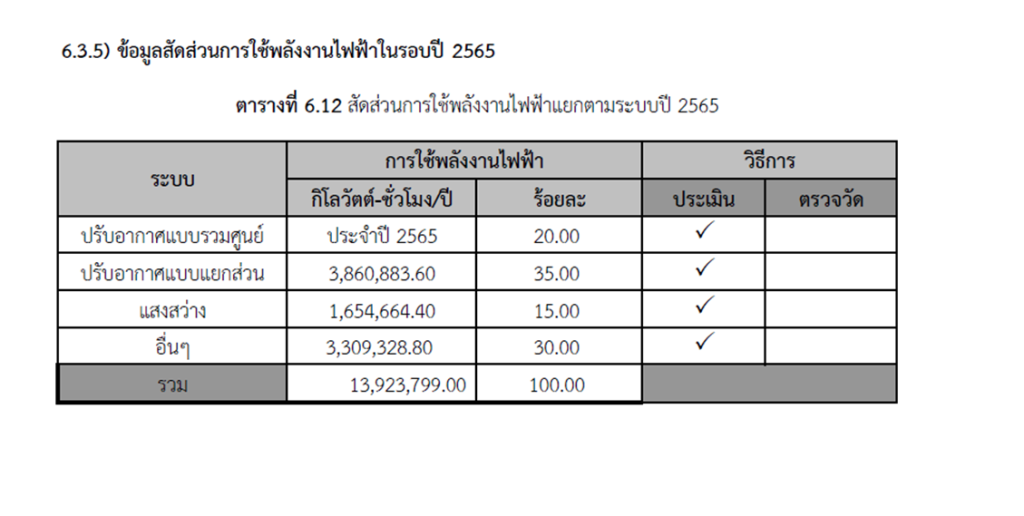
Energy training and workshop
Energy training and workshop in energy conservation tips and simple technical for energy saving have been set up for Energy conservation team and Energy conservation working group from all buildings in KMUTT. Moreover ,energy conservation tips training and workshop have been set up for student and staff, genitors and security guards and outsources services for utilities& maintenances, canteen & restaurant & food center & minimart within our university to understanding their responsibility in energy conservation. Training & Workshop on Energy conservation & Climate Change for all in KMUTT have been operated by Energy Environment & Safety Office (EESH) with 12 trainings & workshops/year. These activities provide simple tips & techniques for all to help our university and their families save energy and reduce green house gas emission and encourage all to work in a team & network with brainstorm activities to innovate a new simple techniques for energy saving and share their knowledge to implement in their work place
Additional evidence link:
- http://anyflip.com/bookcase/fhuxd
- http://www.jseejournal.com/
- http://www.jgsee.kmutt.ac.th/v2/index2.php
- http://www.seem.kmutt.ac.th/research/research-outputs/
- https://sustainable.kmutt.ac.th/energy-and-climate-change/climate-change-mitigation-and-reduction-of-ghgs-emission/
- http://www.ces.kmutt.ac.th/index1.php
- https://www.facebook.com/CESiKMUTT/
- http://www.pr.kmutt.ac.th
6. Related information on our university as a body having a policy on divesting investments from carbon-intensive energy industries especially coal and oil.
We focus on activities related to energy and climate change which comply to SDG 2030 Goal 7-Affordable and clean energy and Goal -Climate action. To Ensure access to affordable, reliable, sustainable and modern energy, KMUTT put our focuses on the use of energy and climate change issues and provide the energy reduction policy, renewable energy usage policy and greenhouse gas emission reduction policy including the energy efficient appliances usage, the implementation of smart buildings /green buildings, total electricity use, energy conservation programs, climate change adaptation and mitigation programs. Moreover, KMUTT has our plan to facilitate access to clean energy research and technology, including renewable energy, energy efficiency and advanced and cleaner fossil-fuel technology, and promote investment in energy infrastructure and clean energy technology.

In response to conserve energy and climate change , KMUTT set up sustainable energy management within KMUTT to
follow the guidelines for energy conservation in designated building, promote the energy conservation and energy
substitution usage within university, KMUTT is committed to
1. Responsibility to climate change and energy sustainability and dedicated to confronting these responsible through
cooperate into all activities on campus.
2. Set up energy management systems including annual implementation plan, monitoring and evaluation system by
continuing to focus on the participation of all sectors of the KMUTT community.
3. Set up the energy conservation rules and procedures and implement to all sectors within KMUTT.
4. Promote and create awareness of energy conservation among staff and students with continual improvement for
sustainability.
5. KMUTT’s Carbon Neutrality 2040
6. 5% renewable energy usage within KMUTT by 2024.
7. 1% energy consumption reduction per capital per year.
| Responsible Office | Policy Administration | Date Issued |
| Energy Environment Safety and Health (EESH) | Assoc. Prof. Dr. Suvit SeaTia | December 2021 |
Building and Ground Management Policy
A policy for the benefit of KMUTT’s Building and Ground
Physical Development Master Plan (41+C)
KMUTT (King Mongkut’s University of Technology Thonburi) sets up a Physical Development Master Plan with the goal of making KMUTT an open place, creating an atmosphere of learning and social participation, a green university, an educational garden, a common space for multi-purpose co-working, and a walking-focused design.
- Appoint an Area Master Plan Committee (AMPC) to consider the master plan, regulate construction, and ensure that the area is used in accordance with the plan.
Design of rooms divider, decorations, renovation or changes in the use of spaces in every building.
The study results of building construction, renovation, and expansion in the KMUTT can be implemented in accordance with the KMUTT’s space utilization criterion standards. There is a guideline for this practice, which is as follows:
- Maximize the benefit of space utilization
- Concern the appropriateness of health and safety
- Benefit of saving energy
- Consider the neatness and beauty of the workplace, as well as a delightful working environment
- Consider the flexibility to shift the process of use.
KMUTT Green & Sustainable Development Policy
Policy development for transforming the KMUTT into a green, sustainable university
Since 2003, the KMUTT has committed to being an environmental leader in all of its activities, including practice, teaching, research and development, with the following commitments:
- To be a model of green university for energy, environmental, and safety management systems in collaboration with the community.
- Intend to produce high-quality graduates who will serve as Thai social change agents for sustainable development.
- Aiming for excellence in accordance with the TQM concept in order to continuously develop and improve the energy, environmental and safety management system
A policy for green university
Revision of the Green university policy in the framework of KMUTT Educational Reform includes:
- Plant the vegetation on the balcony of the President’s Office Building and other buildings to increase the amount of green space, reduce heat entering the building, and reduce the campus heat island.
- Construct the Green Society building to improve collaborative learning and to establish a green social network.
- Provide a walking campus to reduce fuel consumption from cars and pollution in the university by limiting car access and providing a canopy walkway that covering from the sun and rain, as well as a parking area for cars, motorcycles, and bicycles in adequate and appropriate locations. (Operations in 2021)
7.4 ENERGY AND THE COMMUNITY
1. University as a body providing programmes for local community to learn about importance of energy efficiency and clean energy.
Energy Conservation Program

Energy conservation program in KMUTT is the most important issue within the University’s sustainability efforts because it is affected by indefinite market volatility, and can reduce operating costs and CO2 emissions, which contribute to climate change. In order to most effectively address cost and emissions, we must first reduce energy usage. KMUTT Energy usage reduction & Energy conservation program has been set up since 2005 with continual improvement to meet our Energy Conservation Policy and energy usage reduction goal.
Energy conservation program in KMUTT has been concerned on raising awareness on energy usage for sustainable development among our student and staff and social outreach. Energy conservation program in KMUTT consists of two main parts Awareness raising and Technical application.
Awareness raising in KMUTT have been done all year round with Training and Workshop, Exhibition and Road show, Promotion Activities including Energy and Environment Conservation Camp, Green & Clean Campus Network, Green Heart Camp and two outreach for school and community: KMUTT Green School Network and Energy initiation Camp
Technical applications in KMUTT have been done continuously to meet energy usage reduction goal by Energy efficient appliances usage including Energy Reduction in Air Condition System, Energy Reduction in Lighting System, Energy Management by using Energy measuring system, Building Automation System. The technical application by using Energy efficient appliances usage can reduce operating costs and CO2 emissions, which contribute to climate change and make more sustainable for all.
KMUTT Energy Forum

KMUTT Energy Forum was established since 2011. According to KMUTT was recognizing the importance of corporate social responsibility to educating the society in energy issue. Education unit in KMUTT as School of Energy, Environment and Materials and The Joint Graduate School of Energy and Environment are co-operate to organize KMUTT ENERGY FORUM. A propose of this forum is sharing Energy technology management knowledge to public. It is arrange by set up KMUTT ENERGY FORUM 5 times/year indicate an up to date important energy issue in Thailand.
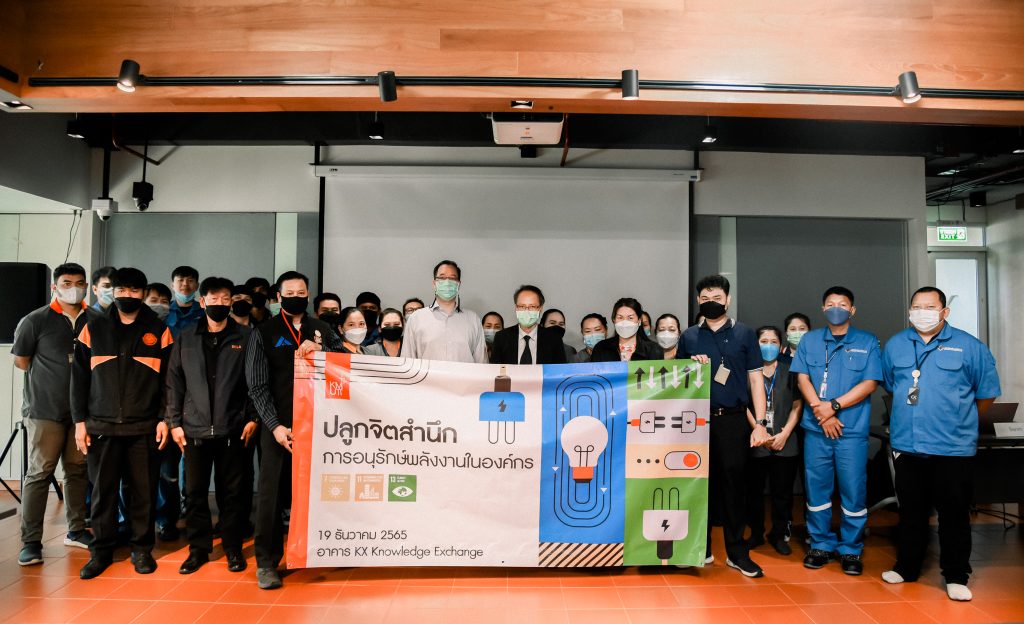
Energy training and workshop
Energy training and workshop in energy conservation tips and simple technical for energy saving have been set up for Energy conservation team and Energy conservation working group from all buildings in KMUTT. Moreover, energy conservation tips training and workshop have been set up for student and staff, genitors and security guard and outsources services for utilities& maintenances, canteen & restaurant & food center & minimart within our university to understanding their responsibility in energy conservation. Training & Workshop on Energy conservation & Climate Change for all in KMUTT have been operated by Energy Environment & Safety Office (EESH) with 12 trainings & workshops/year. These activities provide simple tips & techniques for all to help our university and their families save energy and reduce greenhouse gas emission and encourage all to work in a team & network with brainstorm activities to innovate a new simple technique for energy saving and share their knowledge to implement in their workplace.
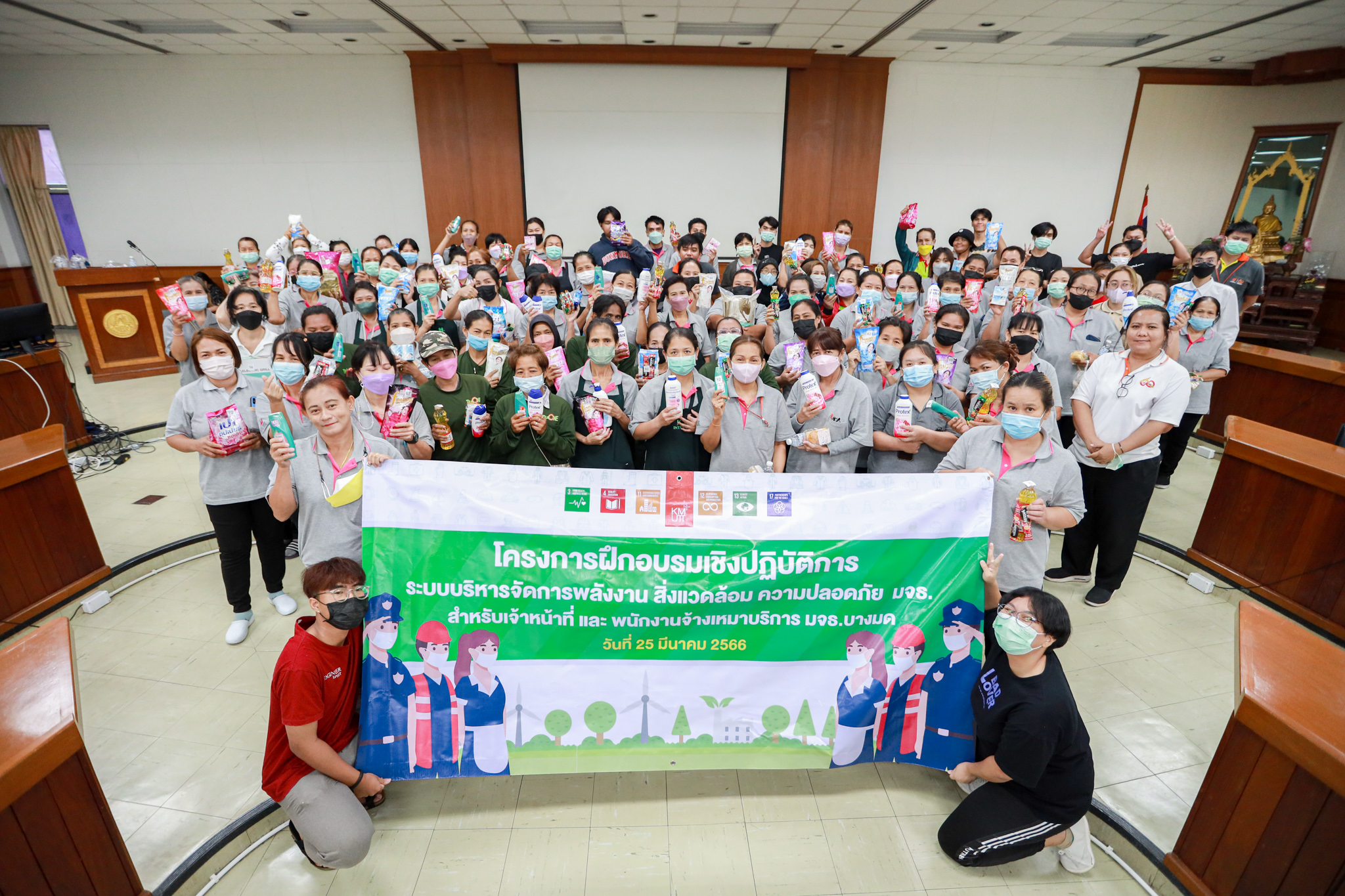
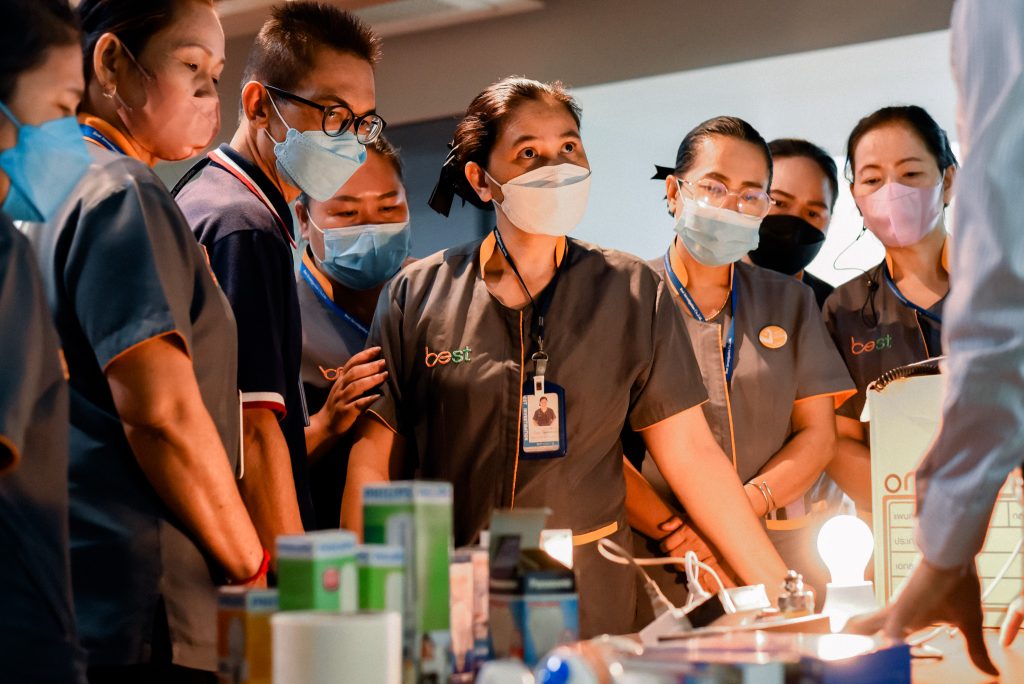

Exhibitions & Road shows
EESH provides Exhibitions & Road shows for Energy conservation & Climate Change for all in KMUTT 10 times/year. These activities provide simple tips & techniques for all to help our university and their families save energy and reduce greenhouse gas emission. Moreover, in Exhibitions and Road shows also have some activities to encourage our students and staff to join our activities as Green & Clean Team and KMUTT Volunteers to help our university on social responsibility for expansion our energy saving and climate changes tips & knowledge for communities and schools surround our campuses.
students&staff to be our GREEN & Clean Team and KMUTT Volunteers to help us expansion the energy saving and climate changes tips & knowledge to schools and communities.



KMUTT provide promotion activities and Energy Saving and reduce Greenhouse gas Campaign by using Poster, Energy saving tips Pocket Guide, Leaflet, Medias and promote to all in KMUTT with monthly promotion activities plan. We are proud that more than 19,000 students and staff joined these activities.






Energy & Environmental conservation Camp
Energy & Environmental conservation Camp for students: KMUTT Green School Network & surround communities. These activities provide one day camp in our campuses, their schools & communities. These activities provide Energy Saving and reduce Greenhouse gas tips and techniques along with environmental conservation followed by the innovative idea for energy saving greenhouse gas reduction.
Goal:700 students joined this camp/year
Results: In 2022, more than 775 students joined Energy camp in KMUTT and more than 20,000 students from 42 of KMUTT Green School Network join the one-day camp on their school.
Green & Clean Campus Network
Green & Clean Campus is Energy and Environment activity for students and Staff in KMUTT. These activities provide guidelines to save energy, waste minimization in KMUTT, separated municipal solid wastes, and Energy-Environment-Safety- Health rule of KMUTT.
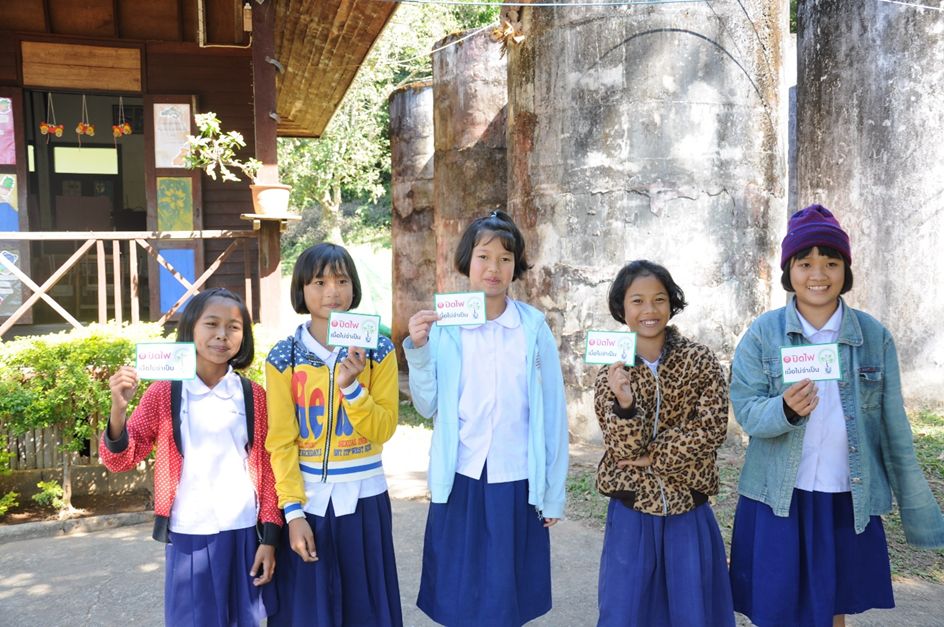
Green Heart Camp
Green Heart Camp with theme “Mod Green New Generation @ KMUTT Bangkuntien 2014” was established on 1 August 2014. The propose of this camp is welcoming a new student of KMUTT. These activities provide Green University policy and Energy Saving tips along with environmental conservation techniques followed by KMUTT Change Agent idea.
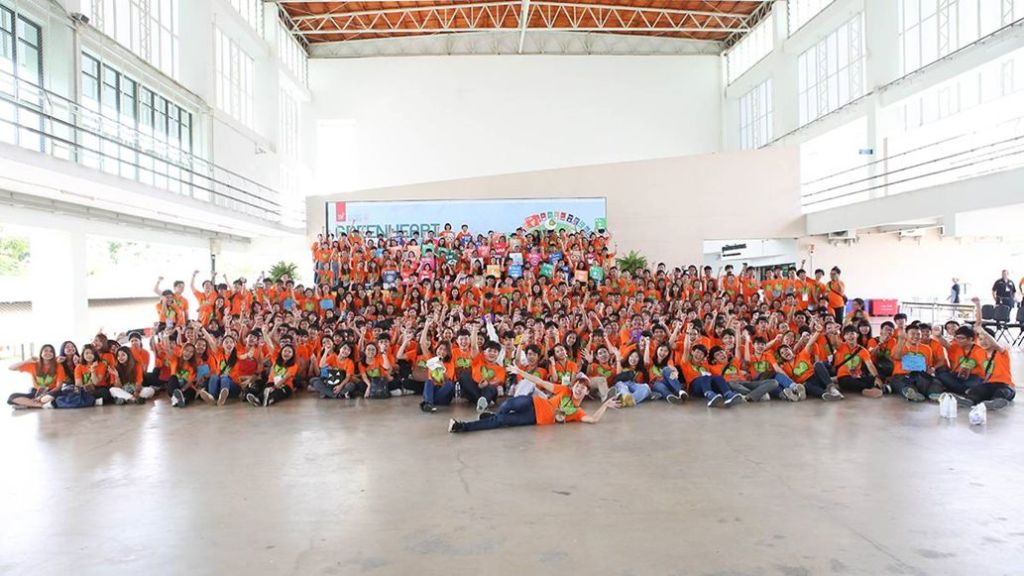
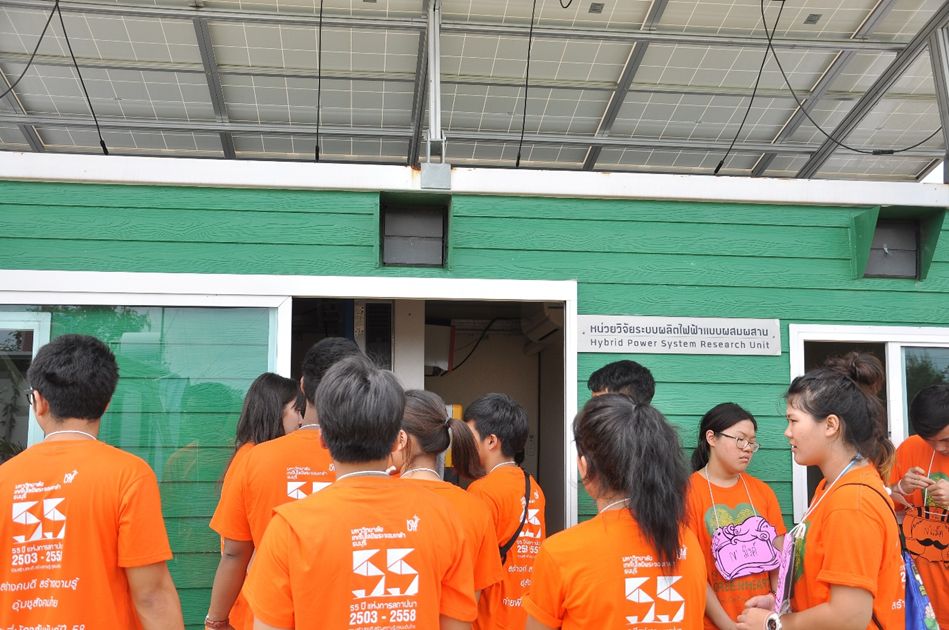
Outreach for school and community:
KMUTT Green School Network
KMUTT focus on knowledge sharing and working on expansion of global warming adaptation and migration to surround schools & communities by our Green & Clean members from students & staff. KMUTT Green School Network has established since 2009 to expand our Energy & Environment conservation to schools including knowledge on Global warming. Currently, we have 50 schools in Bangkok as our KMUTT Green School Network’s member. KMUTT provide Green& Clean activities with exhibition and one day camp for all school members with energy/environment conservation tips, energy global warming reduction plan to implement in their schools continuously.
Outreach for school and community:
Energy initiation Camp
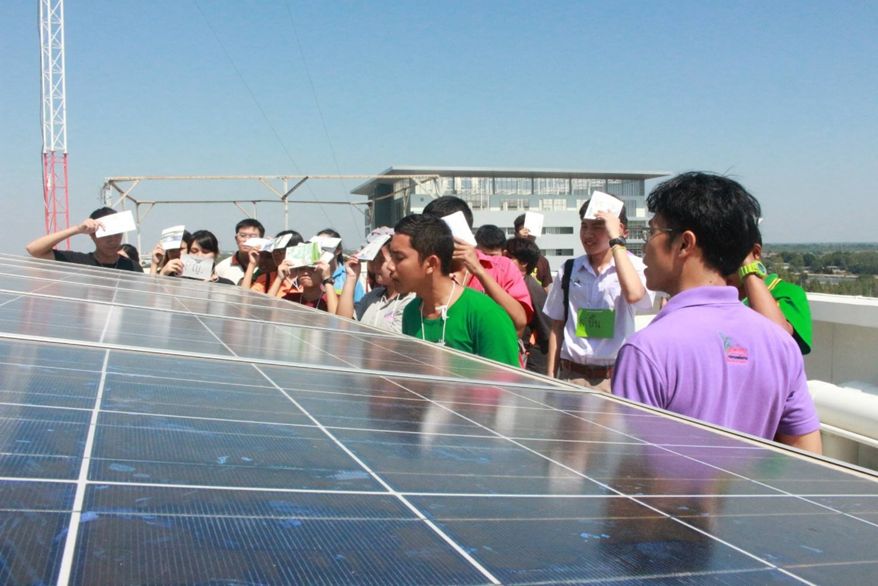
Energy initiation Camp was Operated by Department of Energy. The objective of this camp is to promote Energy & Environment conservation awareness to Thailand youth. This camp established since 2005. KMUTT was co-operated in Central area of Thailand including 22 Provinces.
2. Related information on our university as a body promoting a pledge toward 100% renewable energy (petitions, meetings, discussions, events).

Target: 10% Electrical Energy usage is from renewable sources by 2024
: 2 MW capacity of Solar rooftop was completely installed.
Current Status: In 2024, renewable energy accounted for 3.12% of total final energy consumption of electricity.
: In 2020, 337.12 kW capacity of solar rooftop was installed.
KMUTT promotes to reduces the amount of fossil fuels used by integrating renewable energy with Metropolitan Electricity Authority for electricity consumption within campus. Using renewable energy not only serves the clean energy usage but also serves as Renewable Energy Learning Center for student, researcher and staff. The following table summarize the energy resource and installed capacity.
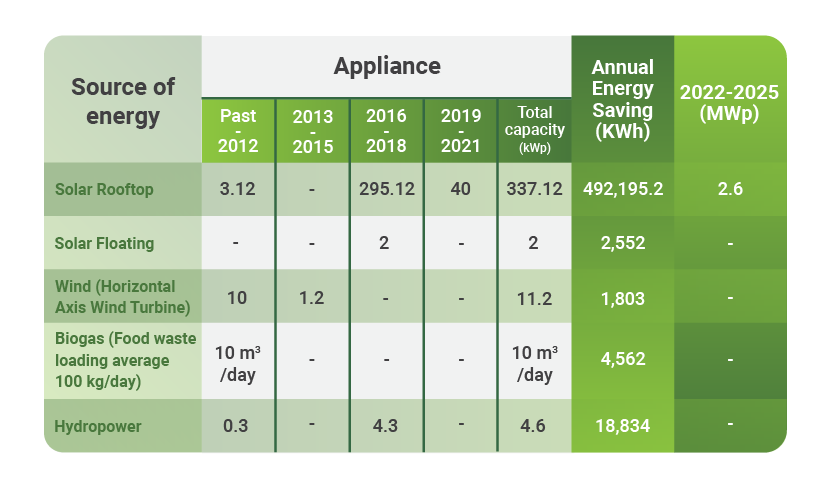
Solar Power
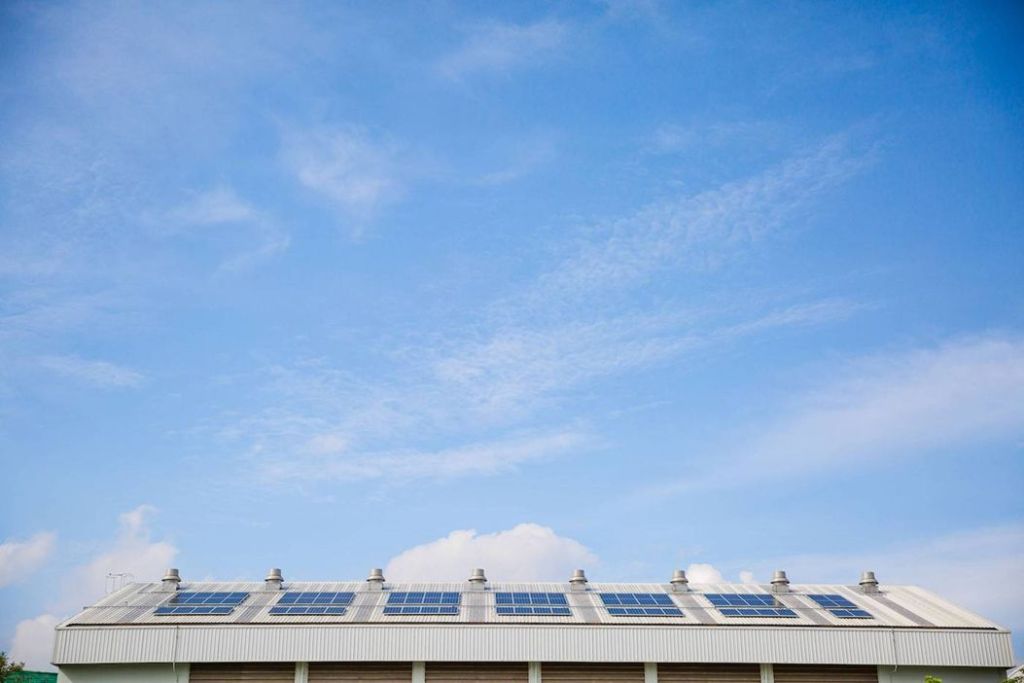
Solar rooftop and solar floating energy in KMUTT campus have the potential growth. At the moment, On-Grid solar rooftop (337.12 kWp) is operated around campus which aim to reduce electricity usage from MEA during peak demand. At the earliest in 2020 university will start to install rooftop solar panels, especially at all building of KMUTT’s Bangmod campus, Bangkhuntien campus and KX Knowledge building, which will conduct its planned to expand the installed capacity up to 2.6 MWp or 5 percentage of total electricity consumption.
15 sets of solar cell have been installed in KMUTT including
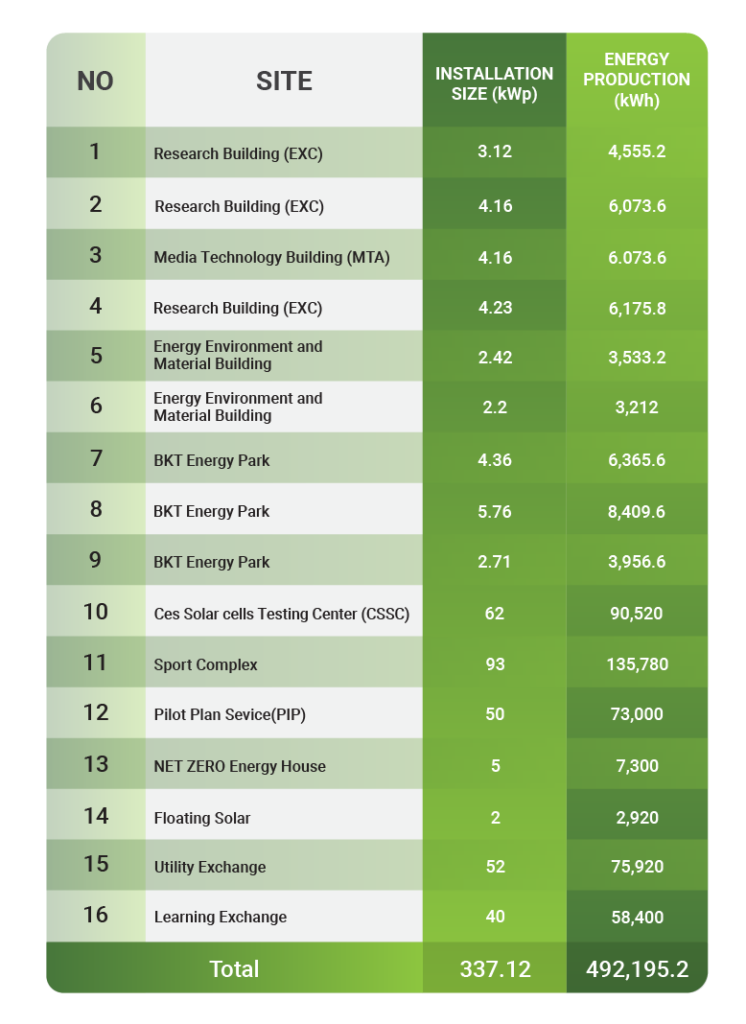
Biogas
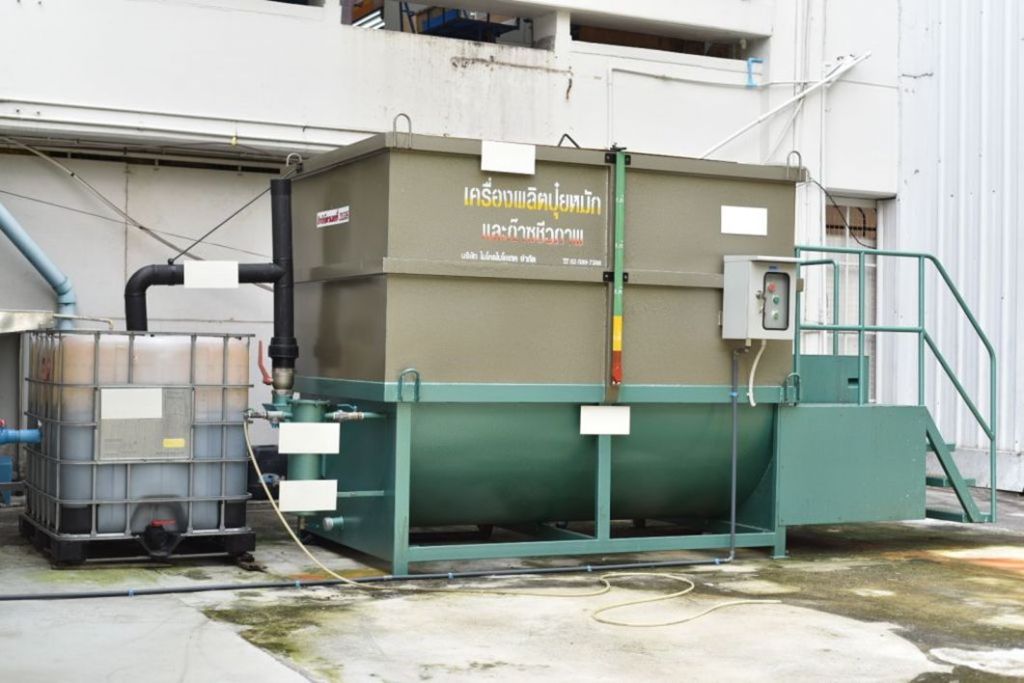
Biogas is an aerobic digestion process where food wastes from KMUTT’s food center are broken down by micro-organisms inside a digester tank with absence of air . At the process, biogas is produced at 18 m3 per day. This methane-rich gas (biogas) is used to boil water for cooking and cleaning at cafeteria. Replace Liquefied petroleum gas with biogas helps cut fossil fuel usage (LPG) more than 9.1% and reduce greenhouse gas emissions within campus up to 4,970 kgCO2. In addition, remaining material (digestate) with rich in nutrients is used as a fertilizer using within campus.
Wind Power

Wind turbines convert the kinetic energy from the wind into mechanical power through blade. After that, this mechanical power would convert into electricity. At KMUTT Bangkhuntien campus, more than 4 Horizontal Axis Wind Turbines are in operation with installed capacity at 11.2 kWp. As a result, wind turbines help to reduce Greenhouse gas emission up to 1,027.71 kg CO2.
Bioethanol Pilot plant
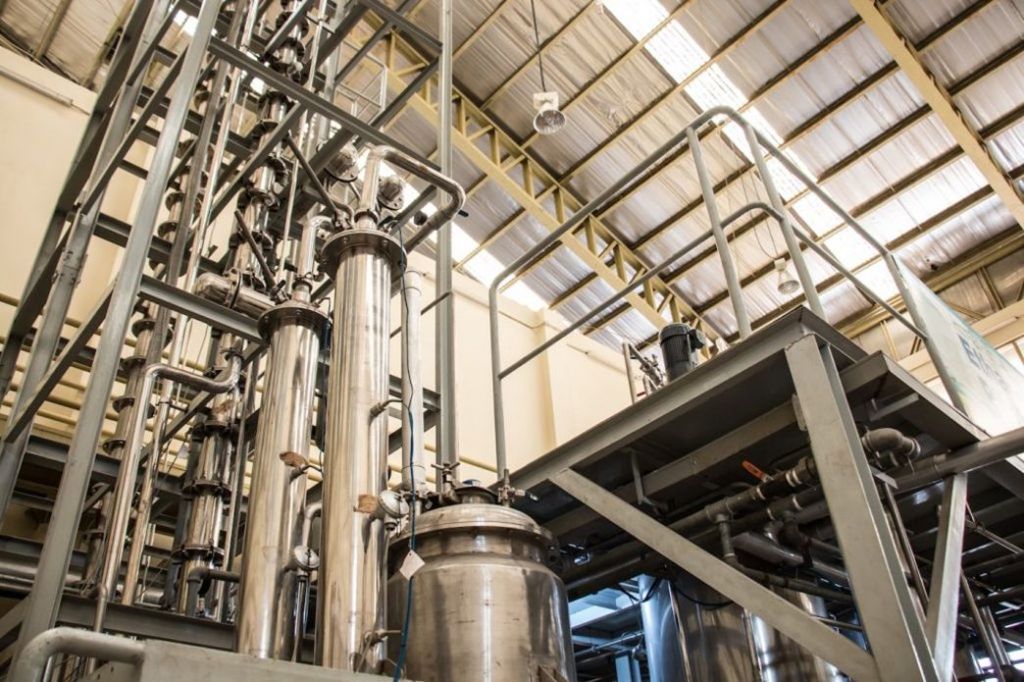
King Mongkut’s University of Technology Thonburi (KMUTT) was implemented energy conservation policy, which promote renewable energy in our campus 5% of energy usage by the year 2020. KMUTT has been developed Bioethanol Pilot Plant which use agricultural waste such as sugar cane, cane molasses and cassava as raw materials for bioethanol production.The Bioethanol pilot plant has been operated since 2010 with 200 Liters of 99.99 % ethanol yield per batch. Bioethanol products from Bioethanol Pilot plant can be used as fuel for Clean Energy Van/Bus such as ED-95 bus/Shutter bus/Van of KMUTT. Bioethanol Pilot plant is not only the scale up facility for Biofuel production in our university, but also it is now acting as the learning space and demonstration site for students, staff to learn more on renewable energy production in KMUTT which helps to promote green and clean technology in Thailand.
Hydropower
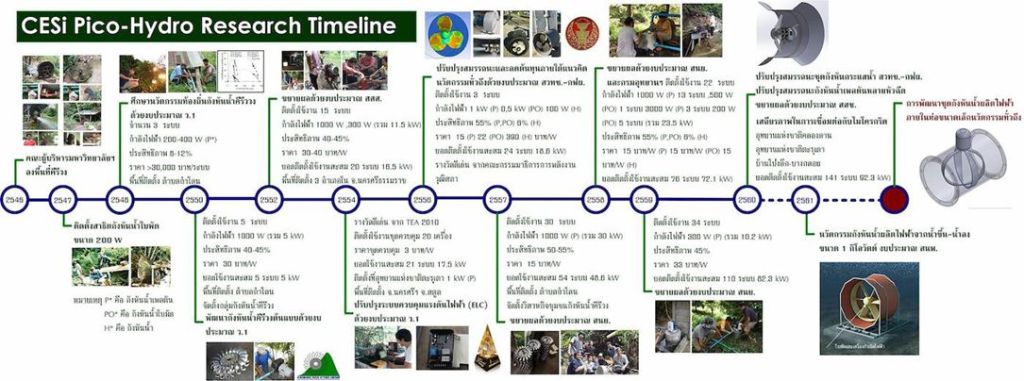
A conversion of energy from flowing water into electricity. At KMUTT Bangkhuntien campus, hydro turbine is installed at 4.6 kWp with annual energy saving at 18,834 KWh/year. Most of research and feasibility study of small-scale hydro turbine and hydropower usage are located at this campus. Furthermore, more than twenty hydro turbines are installed in remote rural area around Thailand where they cannot access to electricity.
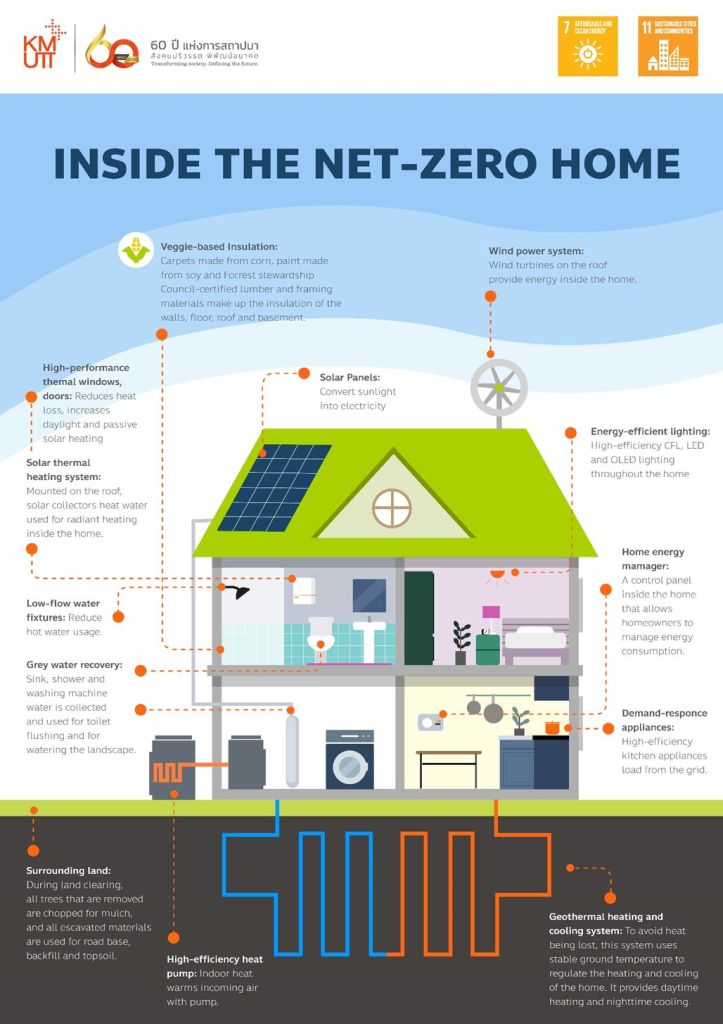
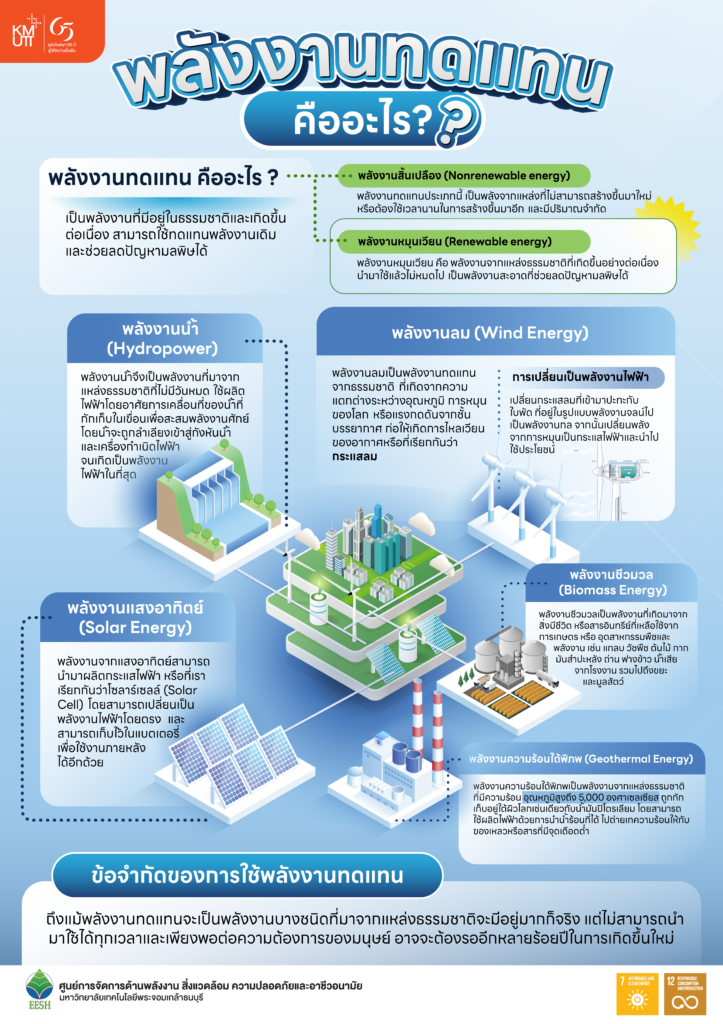
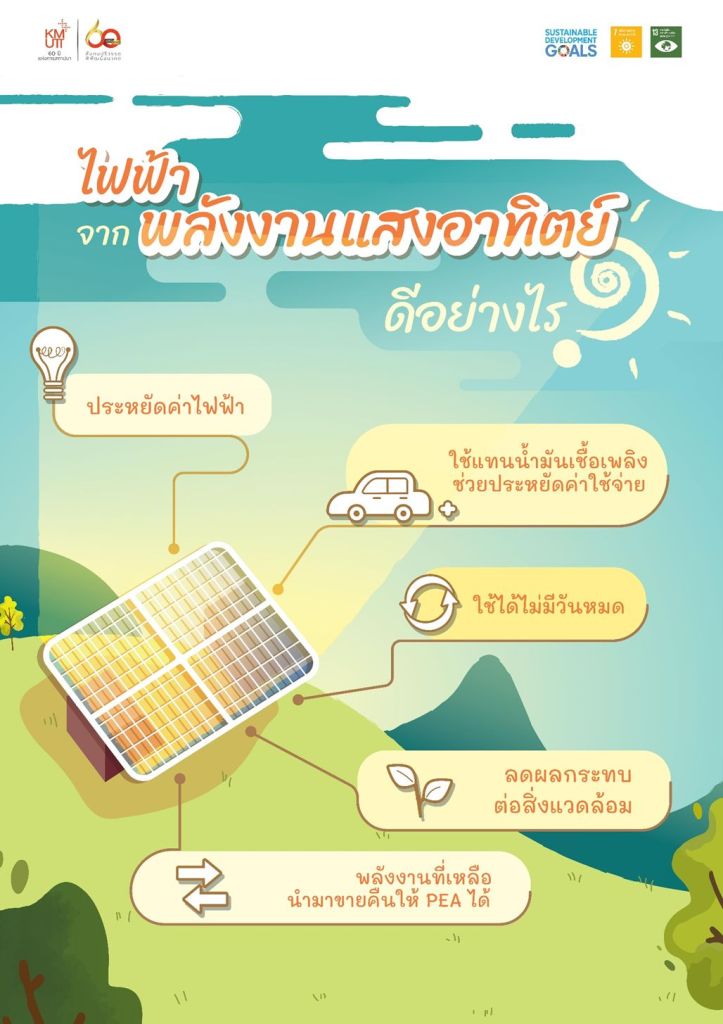
3. Related information on our university as a body providing direct services to local industry aimed at improving energy efficiency and clean energy (energy efficiency assessments, workshops, research renewable energy options).
- Energy training and workshop
Energy training and workshop in energy conservation and energy saving have been trained not only for Energy conservation team and Energy conservation worker, but also to student and staff. All Training and Workshop have been operated by Energy Environment and Safety organization (EESH) with 12 courses/year. These activities provide simple tips and techniques for energy saving and greenhouse gas emission reduction, brainstorming and sharing knowledge to each other. As a result, more than 6,000 attendees along 2 years.
- Exhibitions and Road shows
Exhibitions and road shows for energy conservation & climate change is continuously organized 10 times per year. These activities provide simple tips & techniques in energy saving and greenhouse gas reduction.
- Promotion activities
KMUTT provides promotion activities by using Poster, Energy saving tips Pocket Guide, Leaflet, and Medias to promote within campus with monthly promotion activities plan. As a result, more than 30 promotion activities have been done with more than 19,000 students and staff were join.
- Energy & Environmental conservation Camp
Energy & Environmental conservation Camp for students: KMUTT Green School Network & surround communities. These activities provide one-day camp in our campuses, their schools & communities. These activities provide Energy Saving and reduce Greenhouse gas tips and techniques along with environmental conservation followed by the innovative idea for energy saving and greenhouse gas reduction.
Green Heart Camp
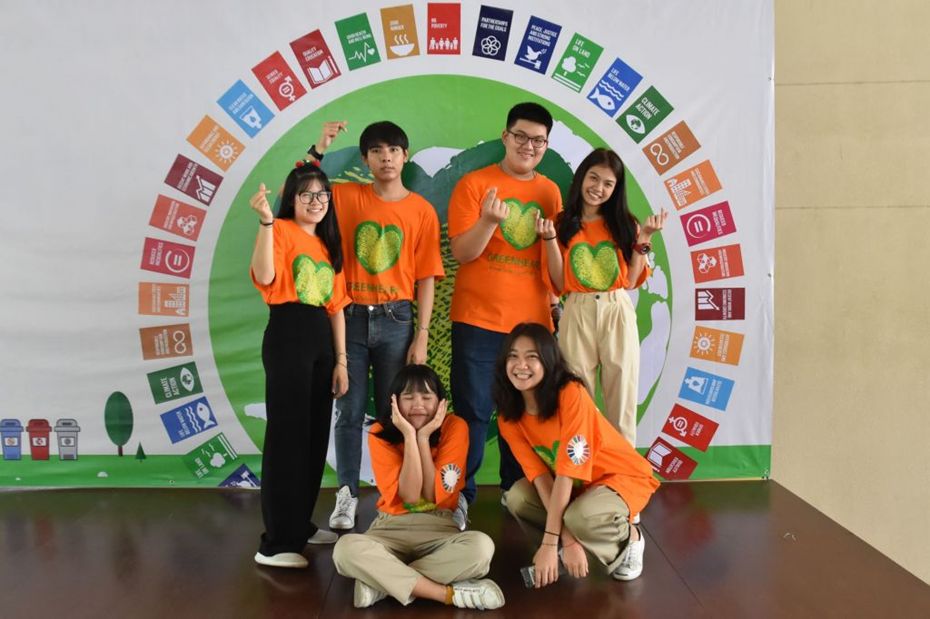
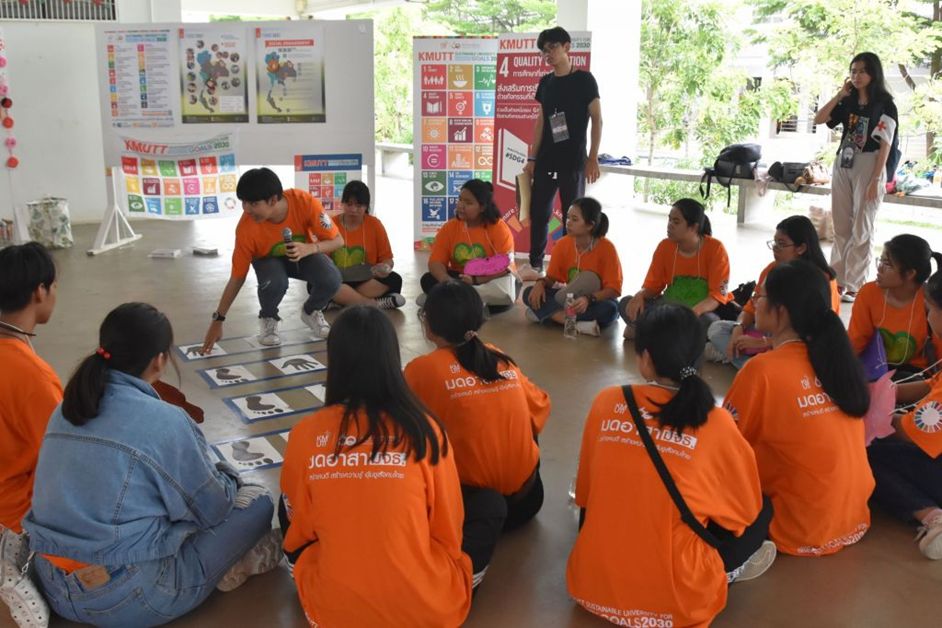
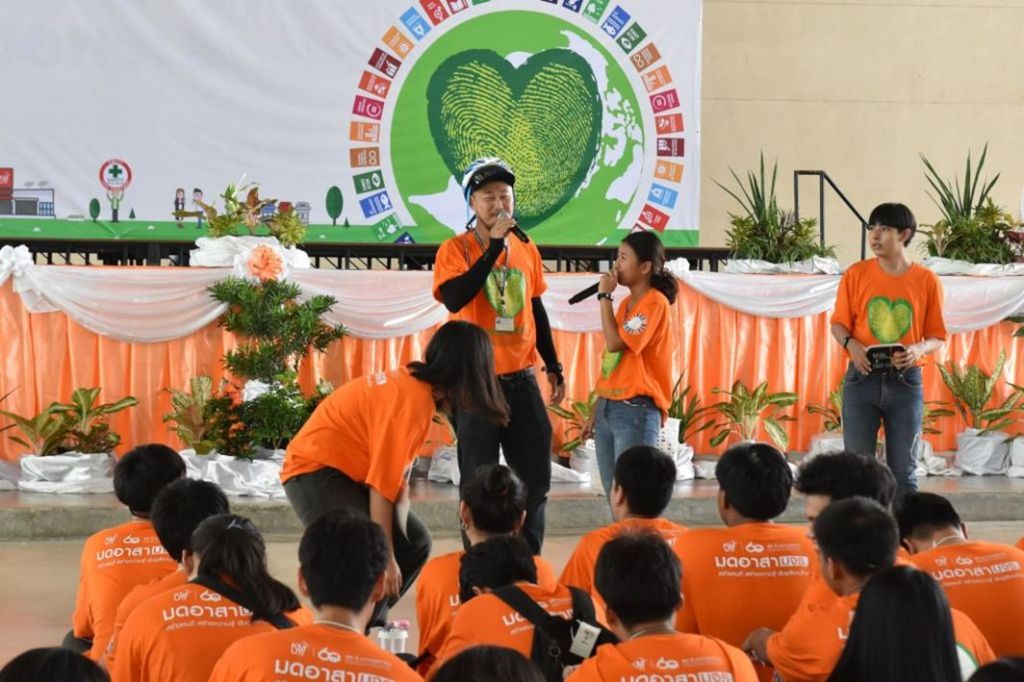
KMUTT Green School Network
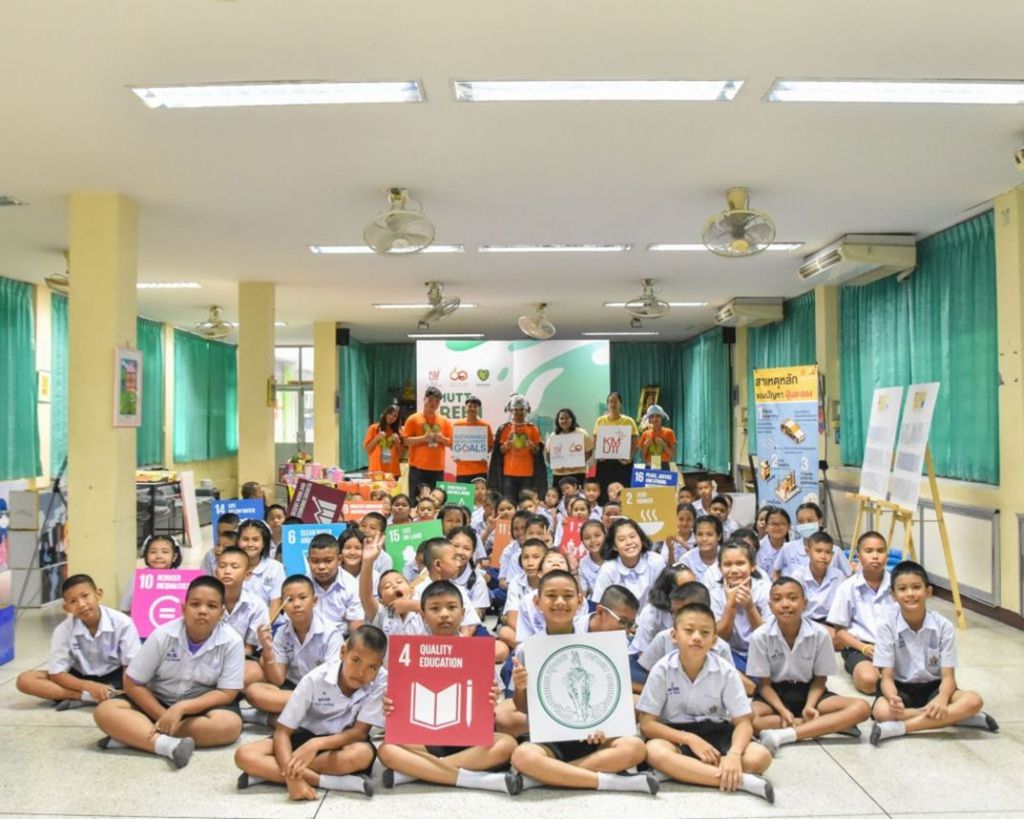
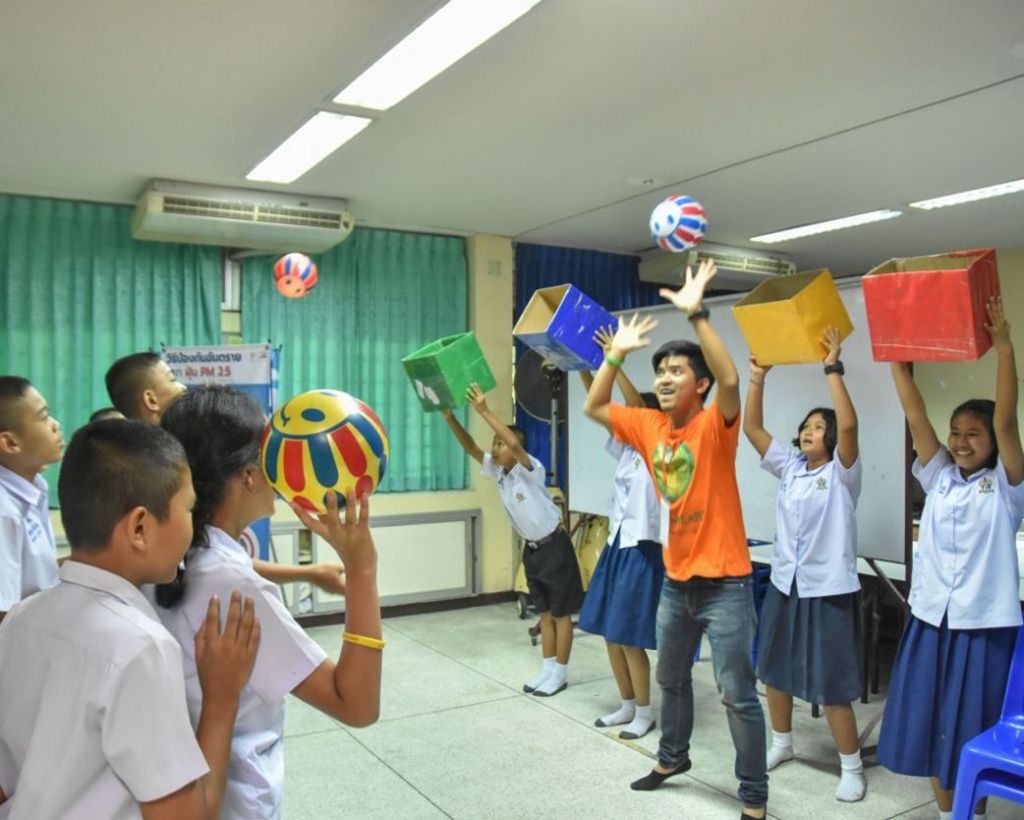
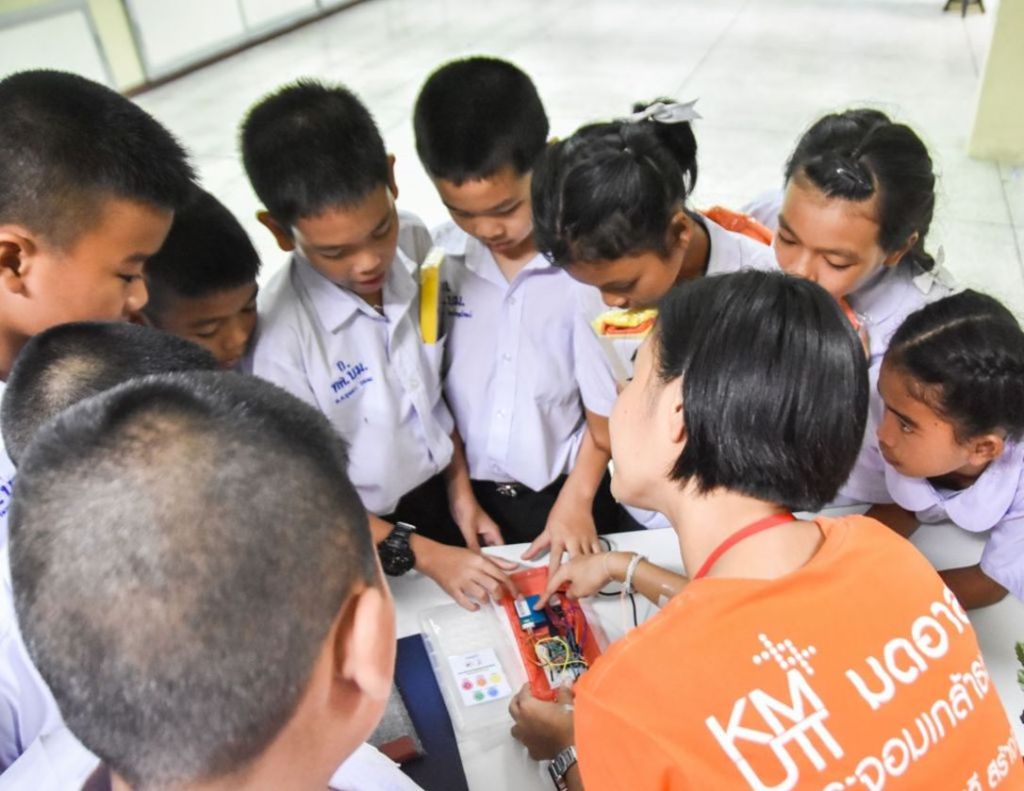
The activity for sharing knowledge on global warming adaptation and migration to surround schools and communities are possible by our green heart student. KMUTT Green School Network has established since 2009 to expand our Energy and Environment conservation to schools including knowledge on Global warming. Presently, more than 50 schools in Bangkok are our KMUTT Green School Network’s member.
Energy initiation Camp Energy initiation Camp was operated by Department of Energy. The objective of this camp is to promote Energy and Environment conservation awareness to Thailand youth. This camp established since 2005. KMUTT was co-operated in Central area of Thailand including 22 Provinces. As a result, more than 325 students were joined under the theme of Energy Innovation for Green Globe.
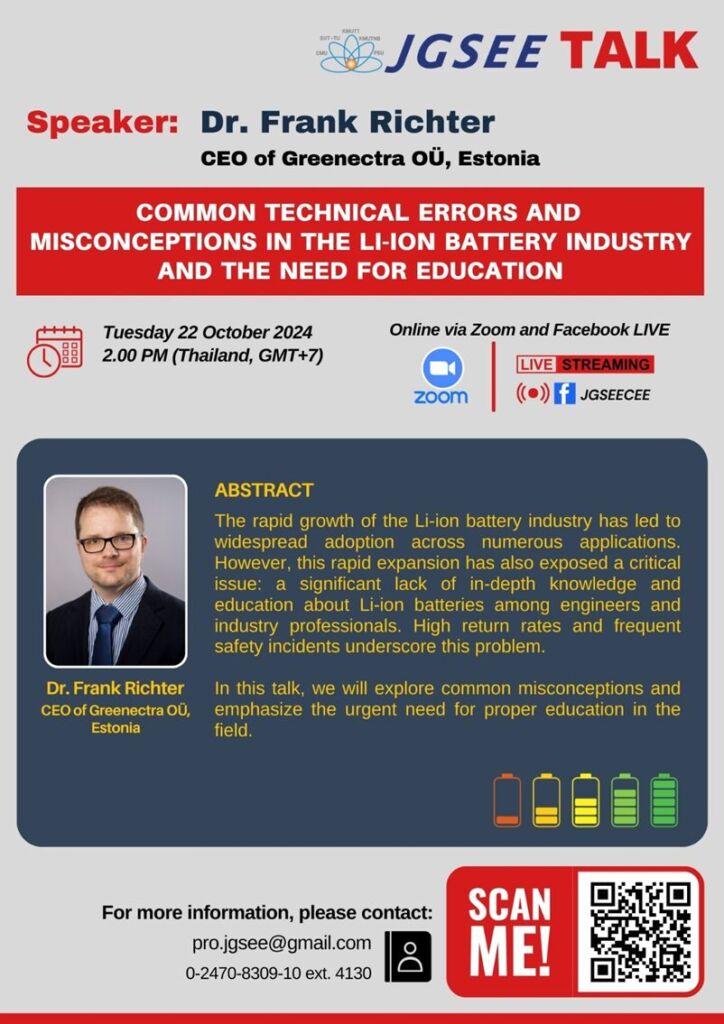
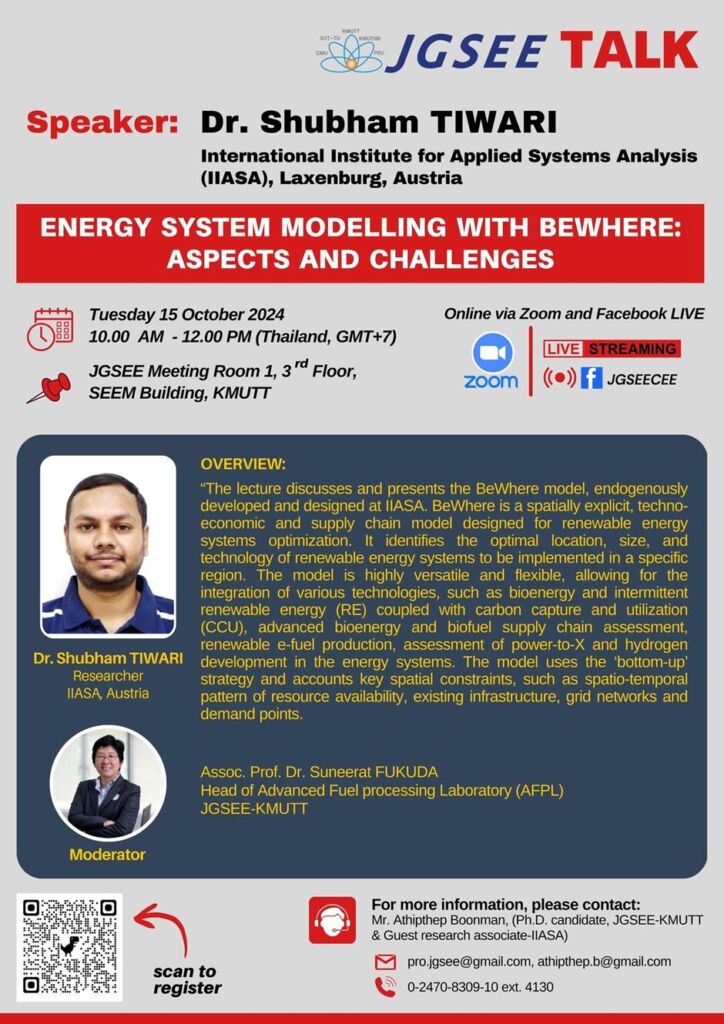

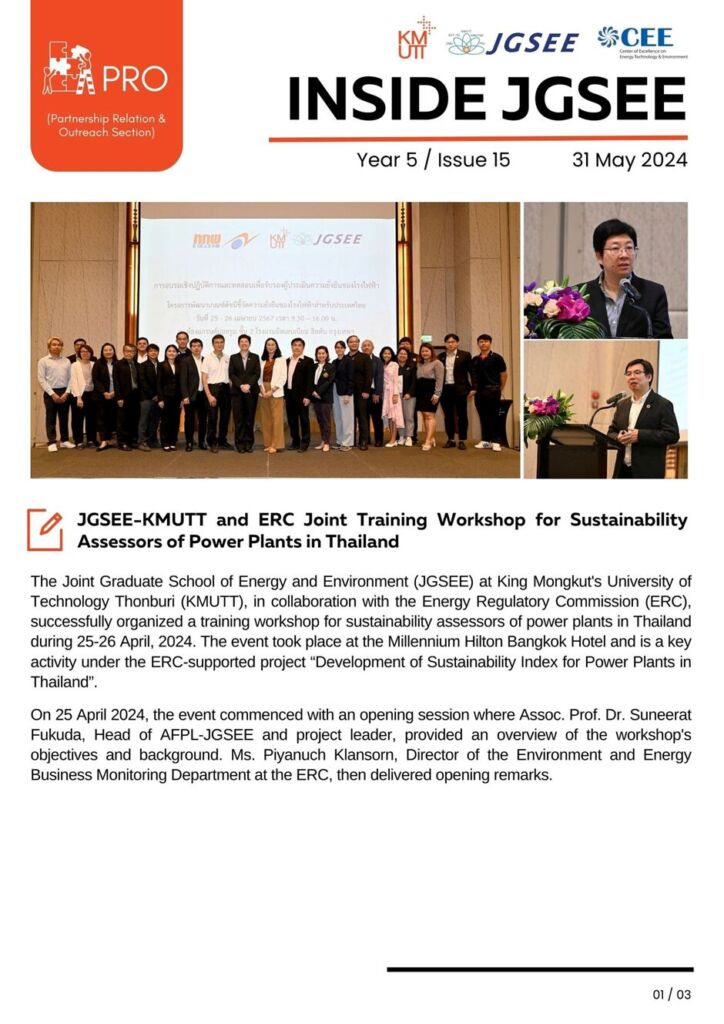
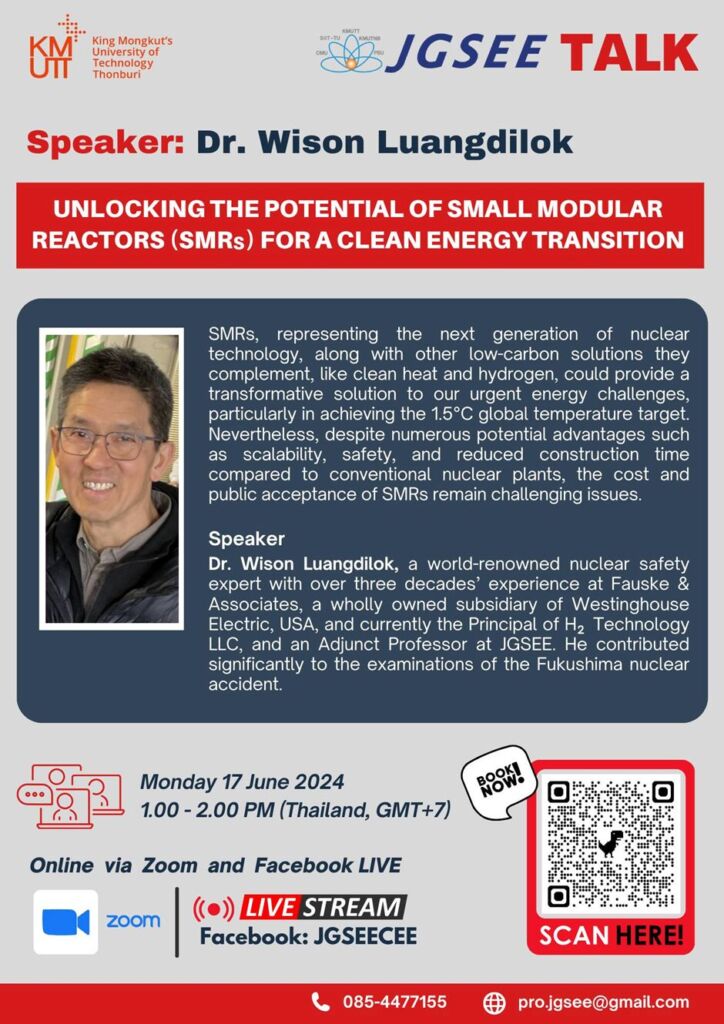
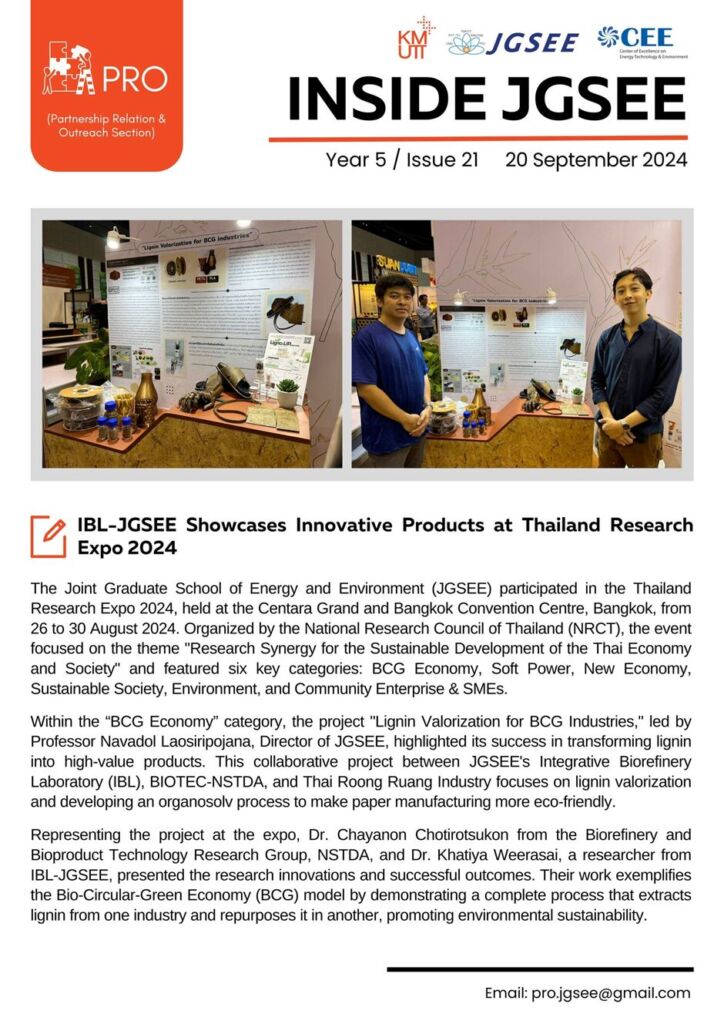
4. Related information on our university as a body on informing and supporting government in clean energy and energy-efficient technology policy development.
Energy and climate change at KMUTT focuses on the activities which comply to SDG 2030 Goal 7-Affordable and clean energy and Goal -Climate action. To ensure access to affordable, reliable, sustainable and modern energy, KMUTT puts our efforts on the use of energy and climate change issues and provide the energy reduction policy, renewable energy usage policy and greenhouse gas emission reduction policy including the energy efficient appliances usage, the implementation of smart buildings /green buildings, total electricity use, energy conservation programs, climate change adaptation and mitigation programs. Moreover, KMUTT has our plan to facilitate access to clean energy research and technology, including renewable energy, energy efficiency and advanced and cleaner fossil-fuel technology, and promote investment in energy infrastructure and clean energy technology.

In response to conserve energy and climate change , KMUTT set up sustainable energy management within KMUTT to
follow the guidelines for energy conservation in designated building, promote the energy conservation and energy
substitution usage within university, KMUTT is committed to
1. Responsibility to climate change and energy sustainability and dedicated to confronting these responsible through
cooperate into all activities on campus.
2. Set up energy management systems including annual implementation plan, monitoring and evaluation system by
continuing to focus on the participation of all sectors of the KMUTT community.
3. Set up the energy conservation rules and procedures and implement to all sectors within KMUTT.
4. Promote and create awareness of energy conservation among staff and students with continual improvement for
sustainability.
5. KMUTT’s Carbon Neutrality 2040
6. 5% renewable energy usage within KMUTT by 2024.
7. 1% energy consumption reduction per capital per year.
| Responsible Office | Policy Administration | Date Issued |
| Energy Environment Safety and Health (EESH) | Assoc. Prof. Dr. Suvit SeaTia | December 2021 |
Building and Ground Management Policy
A policy for the benefit of KMUTT’s Building and Ground
Physical Development Master Plan (41+C)
KMUTT (King Mongkut’s University of Technology Thonburi) sets up a Physical Development Master Plan with the goal of making KMUTT an open place, creating an atmosphere of learning and social participation, a green university, an educational garden, a common space for multi-purpose co-working, and a walking-focused design.
- Appoint an Area Master Plan Committee (AMPC) to consider the master plan, regulate construction, and ensure that the area is used in accordance with the plan.
Design of rooms divider, decorations, renovation or changes in the use of spaces in every building.
The results of our research on building construction, renovation, and expansion in the KMUTT can be implemented in accordance with the KMUTT’s space utilization criterion standards. There is a guideline for this practice, which is as follows:
- Maximize the benefit of space utilization
- Concern the appropriateness of health and safety
- Benefit of saving energy
- Consider the neatness and beauty of the workplace, as well as a delightful working environment
- Consider the flexibility to shift the process of use.
KMUTT Green & Sustainable Development Policy
Policy development for transforming the KMUTT into a green, sustainable university
Since 2003, the KMUTT has been committed to be an environmental leader in all of its activities, including practice, teaching, research and development, with the following commitments:
- To be a model of green university for energy, environmental, and safety management systems in collaboration with the community.
- Intend to produce high-quality graduates who will serve as Thai social change agents for sustainable development.
- Aiming for excellence in accordance with the TQM concept in order to continuously develop and improve the energy, environmental and safety management system
A policy for green university
Revision of the Green university policy in the framework of KMUTT Educational Reform includes:
- Plant the vegetation on the balcony of the President’s Office Building and other buildings to increase the amount of green space, reduce heat entering the building, and reduce the campus heat island.
- Construct the Green Society building to improve collaborative learning and to establish a green social network.
- Provide a walking campus to reduce fuel consumption from cars and pollution in the university by limiting car access and providing a canopy walkway that covering from the sun and rain, as well as a parking area for cars, motorcycles, and bicycles in adequate and appropriate locations. (Available since 2021)
5. Related information on our university as a body on providing assistance for start-ups that foster and support a low-carbon economy/technology.
KMUTT Knowledge Exchange for Innovation Center (KX)
KMUTT has designated the KX building to be the center for facilitating the exchanges of knowledge, technology, and innovation capability between, and among, KMUTT and its academic allies, forward–looking manufacturing enterprises especially SMEs in the strategic sectors, and public organizations, in order to elevate Thailand’s technological and innovation competency, while KMUTT’s faculties and students are granted with opportunities to gain experiences from “Real World” issues, and opportunities to work on real demand–driven research.
KMUTT KX
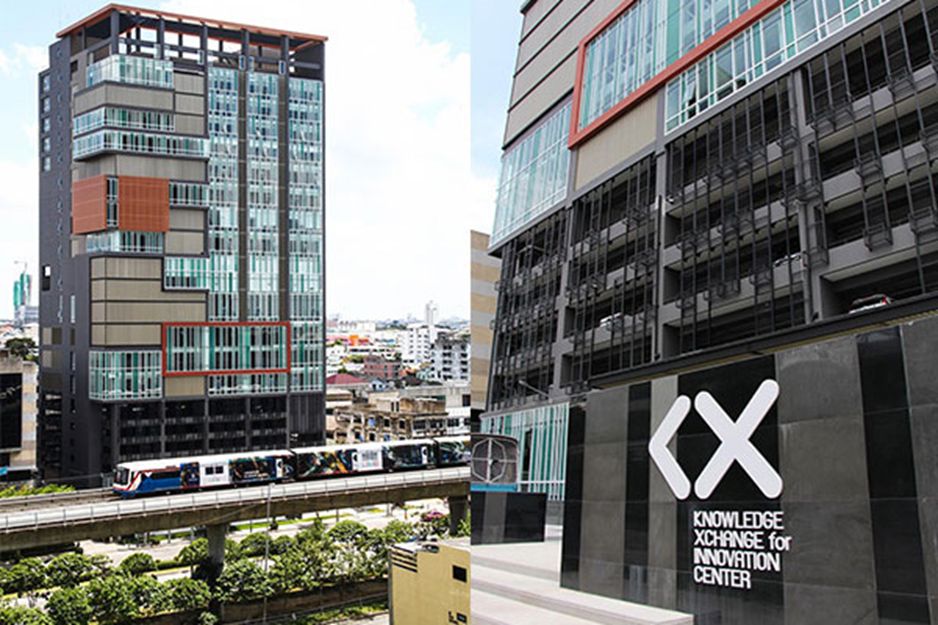
We completed the construction of a new building in 2011 on Krung Thon Buri Road and later called the KX Building, it is a 20–storey building with a total usable area of 20,000 square meters. The building has been designed to be interconnected between each area according to the concept of Interlocking in Space. Activities within the KX building are intended to bring the knowledge and innovation of the university to the utilization by the industrial sector and create competition. Of industrial sectors by small and medium enterprises (SMEs) through knowledge exchange from the education sector, the government and the industrial sector in the form of industry clusters. In addition, there are Startup companies to promote the country’s economic development into a base economy. Innovation includes Design hub consisting of Maker Space and a global design company to support and provide design services to the industry
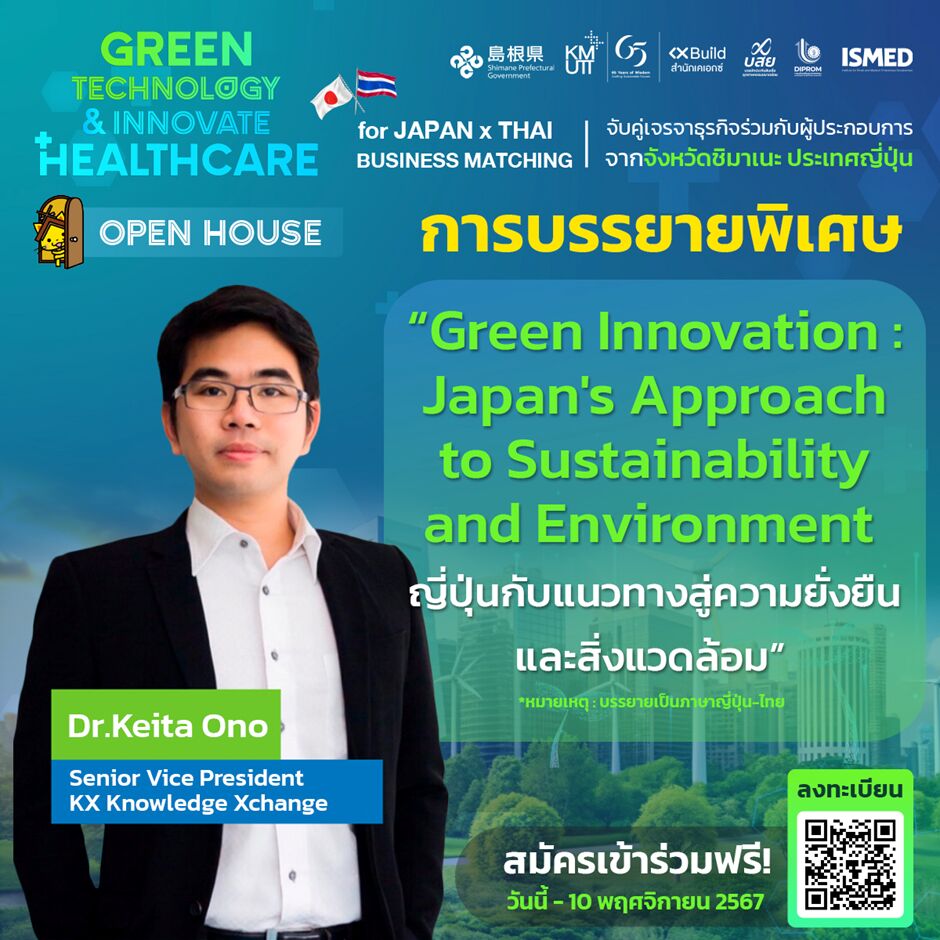

Follow Us https://www.facebook.com/kxinnovation
7.5 LOW-CARBON ENERGY USE
1. Low-carbon energy use
Electricity produced with much lower greenhouse gas emissions over its whole lifecycle than power generation using fossil fuels is known as low-carbon electricity or low-carbon power. One of the most crucial steps needed to slow down climate change is the
switch to low-carbon energy.
Wind, solar, nuclear, and the majority of hydropower are examples of low-carbon power generation sources. Only a small subset of operational fossil fuel power systems—those that are successfully connected with a flue gas carbon capture and storage (CCS) system—are referred to by this term, which mostly leaves out conventional fossil fuel plant sources. In 2020, low-carbon sources accounted for about 40% of the world’s electrical generation: roughly 10% came from nuclear power, roughly 10% from wind and solar, and 20% from hydropower and other renewable energy sources.
KMUTT has been recognized as the outstanding university in Thailand. KMUTT is not only content to just be one of Thailand’s leading engineering universities but also aims to have its impact felt globally. KMUTT has developed the Global Player Strategy, aimed at producing graduates who excel at communication and leadership as well as having outstanding technical skills. Through a combination of hard work and passion for learning and discovery, KMUTT has also offered our excellence in both teaching and research to educate and encourage our students and staff to be a Green University. KMUTT has the responsibility to contribute our knowledge to conduct a role model on energy, environmental safety management systems, which can promote the development of sustainability on our campuses and finally expand to our societies for a better quality of life. The university is committed to be a leader in sustainable development, in all activities from operations, to teaching and research.
Assoc. Prof. Suvit Sae-tia, the dean of KMUTT said, “As of now, climate change has caused various impacts on humanity and the world. We are now seeing more frequent floods, wildfires, heat waves, glacier melting phenomena, and bleached coral reefs that alarmed us of the impending dangers. Such change correlates with the IPCC’s latest research that indicated the global warming situation was approaching a critical point and suggested the governments of worldwide nations take immediate action to change the course of events before it’s too late. Such climate change originates from humans’ needs and deeds and the ever-growing population would lead to more consumption of natural resources and energy.
“Global warming is caused by CO2 emission from human activities. Right now, the situation is approaching the tipping point where the temperature would become irreversibly high. Each nation and organization, big and small, has declared their compliance with the carbon neutrality policies within 2050. KMUTT, as a university with over 20 years’ experience in research in climate change, is well equipped in knowledge, experts, staff, and technology as well as clear strategic goals in sustainable development and is well-recognized as a leading university in energy conservation both domestically and internationally. Such recognition serves as a proof of KMUTT’s understanding of the subject. In support of carbon emission reduction, KMUTT has declared its mission to eliminate its carbon emission to zero within 2040 in the “KMUTT Carbon Neutrality 2040” campaign that shall be accomplished with the use of renewable energy and plantation toabsorb
carbon and thus reduce the impact of climate change. KMUTT also aims for the campaign to be an example. KMUTT also set our finish line ahead of the government to show that all sectors in the country are proactive and are willing to promptly participate when ready. We believe that many other institutes will also respond to the policy, which will be good for the country and our world as well.”
The dean of KMUTT has stated that KMUTT’s priority in carbon neutrality is the result of the university’s plans to become an example for other organizations who might be less ready to learn from, especially private sectors as well as industrial sectors. KMUTT is equipped with expert and viable technologies, thus will be able to inspire them to reduce their carbon emission.
“After our announcement, we will plan out our operation systematically to define appropriate operation in each timeframe which will be evaluated yearly to ensure that we can accomplish each yearly goal up until we achieve carbon neutrality eventually.”







